Fall 2015
Editor’s Note
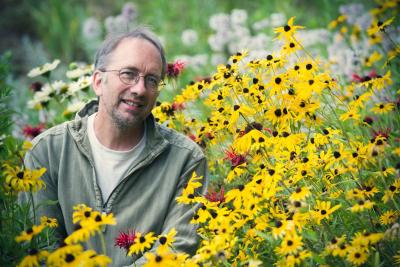 “Over and over I find that endings and beginnings are not as clear-cut as I had imagined, that they necessitate one another, and just…keep happening,” writes Maya Rohr. The eloquent and memorable student speaker at last May’s undergraduate commencement, Maya contributed a suitably apt feature about transformation to this issue of Potash Hill.
“Over and over I find that endings and beginnings are not as clear-cut as I had imagined, that they necessitate one another, and just…keep happening,” writes Maya Rohr. The eloquent and memorable student speaker at last May’s undergraduate commencement, Maya contributed a suitably apt feature about transformation to this issue of Potash Hill.
Much of what keeps happening at Marlboro College, and much of the ground covered in this issue, could fall under the taxonomy and phylogeny of transformation. Perhaps the most prominent example is a welcome to Kevin Quigley, Marlboro’s ninth president, literary scholar, service-learning devotee, international development sage, ordained Buddhist monk, long-distance cyclist, and Irish national backstroke champion. Okay, that last one was a little while ago, but if anyone can embody change it is Kevin, who says his liberal arts education prepared him for “a life unexpected.”
A feature by Catherine O’Callaghan, assistant dean of academic advising, illustrates the impermanence of nature in the religious sites of Nepal visited by her class, then destroyed by earthquakes weeks later. From the profile of alumnus Randy George, who is helping frame a national discussion on workplace policies, to the photo from last May’s Town Meeting, where the Forest Ecology class proposed a forest reserve on college land, this Potash Hill is fairly brimming with transformative examples.
Most readers will recall that Potash Hill itself underwent a major transformation three issues ago. What you might not know is that the new publication received a bronze award for best writing from the Council for Advancement and Support of Education (CASE) District 1.
“The writing here was often wonderful—cerebral, poetic, thoughtful,” according to the judges. “We liked very much that the magazine let other people write—students, alumni, teachers—and there is an intimacy with the reader.” Of course, like any other transformative process, Potash Hill is always a work in progress. I welcome your comments on this issue or on the Marlboro College that keeps happening in your lives.
Inside Front Cover
Potash Hill
Published twice every year, Potash Hill shares highlights of what Marlboro College community members, in both undergraduate and graduate programs, are doing, creating, and thinking. The publication is named after the hill in Marlboro, Vermont, where the undergraduate campus was founded in 1946. “Potash,” or potassium carbonate, was a locally important industry in the 18th and 19th centuries, obtained by leaching wood ash and evaporating the result in large iron pots. Students and faculty at Marlboro no longer make potash, but they are very industrious in their own way, as this publication amply demonstrates.
Editor: Philip Johansson
Photo Editor: Ella McIntosh
Design: New Ground Creative
Potash Hill welcomes letters to the editor. Mail them to: Editor, Potash Hill, Marlboro College, P.O. Box A, Marlboro, VT 05344, or send email to pjohansson@marlboro.edu. The editor reserves the right to edit for length letters that appear in Potash Hill.
Front Cover: The Adirondack chairs in front of Mather have accommodated many an inquiring conversation over the years, with an arresting view of the changing Vermont landscape. You can see more haunting landscapes from photographer Kelly Fletcher, graduate center coordinator, and read what alumna Maya Rohr has to say about “the language and landscape of transformation.” Photo by Kelly Fletcher.
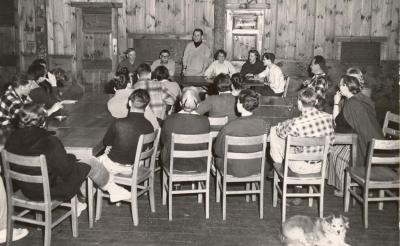 Who remembers Town Meeting? What was the biggest community issue when you were a voting member? Pets? Smoking? Lost mugs? Find out about the experience of Rainbow Stakiwicz ’16 as head selectperson.
Who remembers Town Meeting? What was the biggest community issue when you were a voting member? Pets? Smoking? Lost mugs? Find out about the experience of Rainbow Stakiwicz ’16 as head selectperson.
Marlboro College Mission Statement
The goal of the undergraduate program at Marlboro College is to teach students to think clearly and to learn independently through engagement in a structured program of liberal studies. Students are expected to develop a command of concise and correct English and to strive for academic excellence informed by intellectual and artistic creativity; they are encouraged to acquire a passion for learning, discerning judgment, and a global perspective. The college promotes independence by requiring students to participate in the planning of their own programs of study and to act responsibly within a self-governing community.
The mission of Marlboro College Graduate and Professional Studies program is to offer responsive, innovative education of the highest standard in professional studies in the topic areas of management, technology, and teaching. The educational practice of the graduate program fosters the development of critical thinking, articulate presentation, coherent concepts and arguments, superior writing skills, and the ability to apply creative, sustainable solutions to real world problems.
Up Front

Workers ankle-deep in cement pour the floor of the new Snyder Center for the Visual Arts in August. “After years of planning, we watch daily with real excitement as the Snyder Center rises toward completion,” says Tim Segar, visual arts professor. “This addition to the campus will include studios and two classrooms, one of which we will hold open for non-art classes, insuring that students from across the curriculum will enjoy this new structure and come in close contact with the work of art students.”
Clear Writing
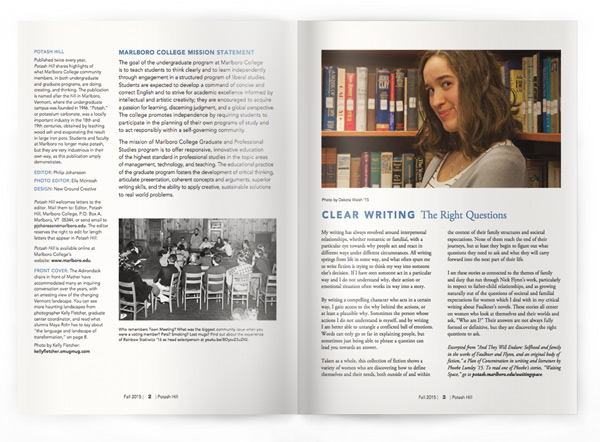
The Right Questions
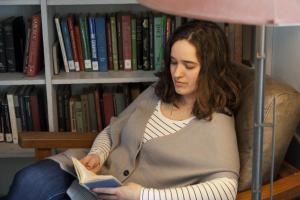 My writing has always revolved around interpersonal relationships, whether romantic or familial, with a particular eye towards why people act and react in different ways under different circumstances. All writing springs from life in some way, and what often spurs me to write fiction is trying to think my way into someone else’s decision. If I have seen someone act in a particular way and I do not understand why, their action or emotional situation often works its way into a story.
My writing has always revolved around interpersonal relationships, whether romantic or familial, with a particular eye towards why people act and react in different ways under different circumstances. All writing springs from life in some way, and what often spurs me to write fiction is trying to think my way into someone else’s decision. If I have seen someone act in a particular way and I do not understand why, their action or emotional situation often works its way into a story.
By writing a compelling character who acts in a certain way, I gain access to the why behind the actions, or at least a plausible why. Sometimes the person whose actions I do not understand is myself, and by writing I am better able to untangle a conflicted ball of emotions. Words can only go so far in explaining people, but sometimes just being able to phrase a question can lead you towards an answer.
Taken as a whole, this collection of fiction shows a variety of women who are discovering how to define themselves and their needs, both outside of and within the context of their family structures and societal expectations. None of them reach the end of their journeys, but at least they begin to figure out what questions they need to ask and what they will carry forward into the next part of their life.
I see these stories as connected to the themes of family and duty that run through Nick Flynn’s work, particularly in respect to father-child relationships, and as growing naturally out of the questions of societal and familial expectations for women which I deal with in my critical writing about Faulkner’s novels. These stories all center on women who look at themselves and their worlds and ask, “Who am I?” Their answers are not always fully formed or definitive, but they are discovering the right questions to ask.
Excerpted from “And They Will Endure: Selfhood and family in the works of Faulkner and Flynn, and an original body of fiction,” a Plan of Concentration in writing and literature by Phoebe Lumley ’15. Read one of Phoebe’s stories, “Waiting Space." Photos by Dakota Walsh ’15
Letters
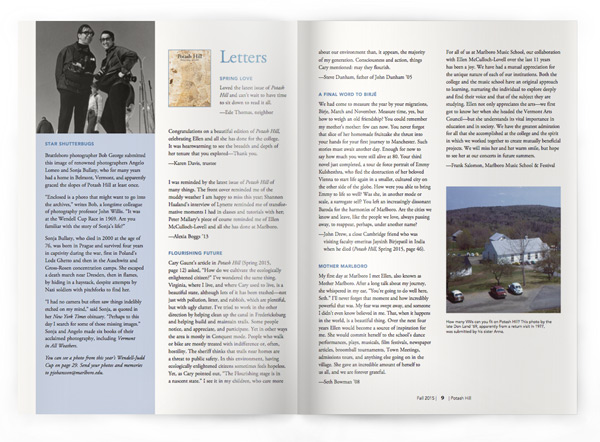
Star Shutterbugs 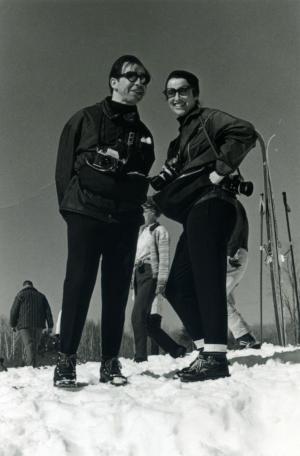 Brattleboro photographer Bob George submitted this image of renowned photographers Angelo Lomeo and Sonja Bullaty, who for many years had a home in Belmont, Vermont, and apparently graced the slopes of Potash Hill at least once.
Brattleboro photographer Bob George submitted this image of renowned photographers Angelo Lomeo and Sonja Bullaty, who for many years had a home in Belmont, Vermont, and apparently graced the slopes of Potash Hill at least once.
“Enclosed is a photo that might want to go into the archives,” writes Bob, a longtime colleague of photography professor John Willis. “It was at the Wendell Cup Race in 1969. Are you familiar with the story of Sonja’s life?”
Sonja Bullaty, who died in 2000 at the age of 76, was born in Prague and survived four years in captivity during the war, first in Poland’s Lodz Ghetto and then in the Auschwitz and Gross-Rosen concentration camps. She escaped a death march near Dresden, then in flames, by hiding in a haystack, despite attempts by Nazi soldiers with pitchforks to find her.
“I had no camera but often saw things indelibly etched on my mind,” said Sonja, as quoted in her New York Times obituary. “Perhaps to this day I search for some of those missing images.” Sonja and Angelo made six books of their acclaimed photography, including Vermont in All Weathers.
You can see a photo from this year’s Wendell-Judd Cup. Send your photos and memories to pjohansson@marlboro.edu.
Spring Love
Loved the latest issue of Potash Hill and can’t wait to have time to sit down to read it all.
—Ede Thomas, neighbor
Congratulations on a beautiful edition of Potash Hill, celebrating Ellen and all she has done for the college. It was heartwarming to see the breadth and depth of her tenure that you explored—Thank you.
—Karen Davis, trustee
I was reminded by the latest issue of Potash Hill of many things. The front cover reminded me of the muddy weather I am happy to miss this year; Shannon Haaland’s interview of Lynette reminded me of transformative moments I had in classes and tutorials with her; Peter Mallary’s piece of course reminded me of Ellen McCulloch-Lovell and all she has done at Marlboro.
—Alexia Boggs ’13
Flourishing Future
Cary Gaunt’s article in Potash Hill (Spring 2015, page 12) asked, “How do we cultivate the ecologically enlightened citizen?” I’ve wondered the same thing. Virginia, where I live, and where Cary used to live, is a beautiful state, although lots of it has been trashed—not just with pollution, litter, and rubbish, which are plentiful, but with ugly clutter. I’ve tried to work in the other direction by helping clean up the canal in Fredericksburg and helping build and maintain trails. Some people notice, and appreciate, and participate. Yet in other ways the area is mostly in Conquest mode. People who walk or bike are mostly treated with indifference or, often, hostility. The sheriff thinks that trails near homes are a threat to public safety. In this environment, having ecologically enlightened citizens sometimes feels hopeless. Yet, as Cary pointed out, “The Flourishing stage is in a nascent state.” I see it in my children, who care moreabout our environment than, it appears, the majority of my generation. Consciousness and action, things Cary mentioned: may they flourish.
—Steve Dunham, father of John Dunham ’05
A Final Word to Birjé
We had come to measure the year by your migrations, Birje, March and November. Measure time, yes, but how to weigh an old friendship? You could remember my mother’s mother: few can now. You never forgot that slice of her homemade fruitcake she thrust into your hands for your first journey to Manchester. Such stories must await another day. Enough for now to say how much you were still alive at 80. Your third novel just completed, a tour de force portrait of Emmy Kulshesthra, who fled the destruction of her beloved Vienna to start life again in a smaller, cultured city on the other side of the globe. How were you able to bring Emmy to life so well? Was she, in another mode or scale, a surrogate self? You left an increasingly dissonant Baroda for the harmonies of Marlboro. Are the cities we know and leave, like the people we love, always passing away, to reappear, perhaps, under another name?
— John Drew, a close Cambridge friend who was visiting faculty emeritus Jaysinh Birjepatil in India when he died (Potash Hill, Spring 2015, page 46).
Mother Marlboro
My first day at Marlboro I met Ellen, also known as Mother Marlboro. After a long talk about my journey, she whispered in my ear, “You’re going to do well here, Seth.” I’ll never forget that moment and how incredibly powerful that was. My fear was swept away, and someone I didn’t even know believed in me. That, when it happens in the world, is a beautiful thing. Over the next four years Ellen would become a source of inspiration for me. She would commit herself to the school’s dance performances, plays, musicals, film festivals, newspaper articles, broomball tournaments, Town Meetings, admissions tours, and anything else going on in the village. She gave an incredible amount of herself to us all, and we are forever grateful.
—Seth Bowman ’08
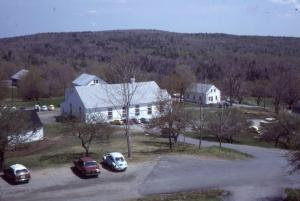 For all of us at Marlboro Music School, our collaboration with Ellen McCulloch-Lovell over the last 11 years has been a joy. We have had a mutual appreciation for the unique nature of each of our institutions. Both the college and the music school have an original approach to learning, nurturing the individual to explore deeply and find their voice and that of the subject they are studying. Ellen not only appreciates the arts—we first got to know her when she headed the Vermont Arts Council—but she understands its vital importance in education and in society. We have the greatest admiration for all that she accomplished at the college and the spirit in which we worked together to create mutually beneficial projects. We will miss her and her warm smile, but hope to see her at our concerts in future summers.
For all of us at Marlboro Music School, our collaboration with Ellen McCulloch-Lovell over the last 11 years has been a joy. We have had a mutual appreciation for the unique nature of each of our institutions. Both the college and the music school have an original approach to learning, nurturing the individual to explore deeply and find their voice and that of the subject they are studying. Ellen not only appreciates the arts—we first got to know her when she headed the Vermont Arts Council—but she understands its vital importance in education and in society. We have the greatest admiration for all that she accomplished at the college and the spirit in which we worked together to create mutually beneficial projects. We will miss her and her warm smile, but hope to see her at our concerts in future summers.
—Frank Salomon, Marlboro Music School & Festival
Breaking Light: The Language and Landscape of Transformation
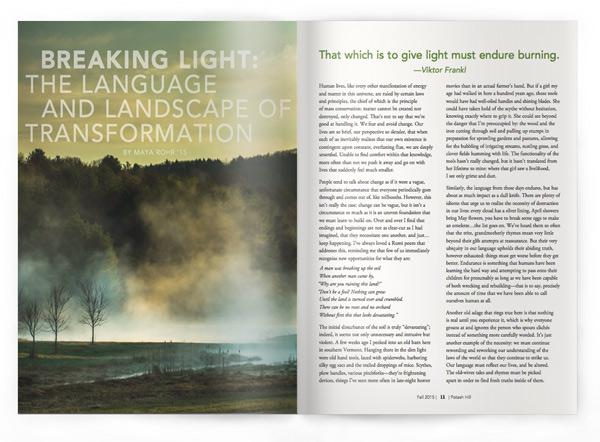
By Maya Rohr ‘15
That which is to give light must endure burning. —Viktor Frankl
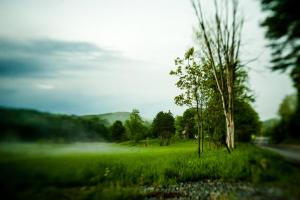 Human lives, like every other manifestation of energy and matter in this universe, are ruled by certain laws and principles, the chief of which is the principle of mass conservation: matter cannot be created nor destroyed, only changed. That’s not to say that we’re good at handling it. We fear and avoid change. Our lives are so brief, our perspective so slender, that when each of us inevitably realizes that our own existence is contingent upon constant, everlasting flux, we are deeply unsettled. Unable to find comfort within that knowledge, more often than not we push it away and go on with lives that suddenly feel much smaller.
Human lives, like every other manifestation of energy and matter in this universe, are ruled by certain laws and principles, the chief of which is the principle of mass conservation: matter cannot be created nor destroyed, only changed. That’s not to say that we’re good at handling it. We fear and avoid change. Our lives are so brief, our perspective so slender, that when each of us inevitably realizes that our own existence is contingent upon constant, everlasting flux, we are deeply unsettled. Unable to find comfort within that knowledge, more often than not we push it away and go on with lives that suddenly feel much smaller.
People tend to talk about change as if it were a vague, unfortunate circumstance that everyone periodically goes through and comes out of, like tollbooths. However, this isn’t really the case: change can be vague, but it isn’t a circumstance so much as it is an uneven foundation that we must learn to build on. Over and over I find that endings and beginnings are not as clear-cut as I had imagined, that they necessitate one another, and just… keep happening. I’ve always loved a Rumi poem that addresses this, reminding me that few of us immediately recognize new opportunities for what they are:
A man was breaking up the soil
When another man came by,
“Why are you ruining this land?”
“Don’t be a fool! Nothing can grow
Until the land is turned over and crumbled.
There can be no roses and no orchard
Without first this that looks devastating.”
 The initial disturbance of the soil is truly “devastating”; indeed, it seems not only unnecessary and intrusive but violent. A few weeks ago I peeked into an old barn here in southern Vermont. Hanging there in the dim light were old hand tools, laced with spiderwebs, harboring silky egg sacs and the trailed droppings of mice. Scythes, plow handles, various pitchforks—they’re frightening devices, things I’ve seen more often in late-night horror movies than in an actual farmer’s hand. But if a girl my age had walked in here a hundred years ago, those tools would have had well-oiled handles and shining blades. She could have taken hold of the scythe without hesitation, knowing exactly where to grip it. She could see beyond the danger that I’m preoccupied by: the wood and the iron cutting through soil and pulling up stumps in preparation for sprawling gardens and pastures, allowing for the bubbling of irrigating streams, rustling grass, and clover fields humming with life. The functionality of the tools hasn’t really changed, but it hasn’t translated from her lifetime to mine: where that girl saw a livelihood, I see only grime and dust.
The initial disturbance of the soil is truly “devastating”; indeed, it seems not only unnecessary and intrusive but violent. A few weeks ago I peeked into an old barn here in southern Vermont. Hanging there in the dim light were old hand tools, laced with spiderwebs, harboring silky egg sacs and the trailed droppings of mice. Scythes, plow handles, various pitchforks—they’re frightening devices, things I’ve seen more often in late-night horror movies than in an actual farmer’s hand. But if a girl my age had walked in here a hundred years ago, those tools would have had well-oiled handles and shining blades. She could have taken hold of the scythe without hesitation, knowing exactly where to grip it. She could see beyond the danger that I’m preoccupied by: the wood and the iron cutting through soil and pulling up stumps in preparation for sprawling gardens and pastures, allowing for the bubbling of irrigating streams, rustling grass, and clover fields humming with life. The functionality of the tools hasn’t really changed, but it hasn’t translated from her lifetime to mine: where that girl saw a livelihood, I see only grime and dust.
Similarly, the language from those days endures, but has about as much impact as a dull knife. There are plenty of idioms that urge us to realize the necessity of destruction in our lives: every cloud has a silver lining, April showers bring May flowers, you have to break some eggs to make an omelette…the list goes on. We’ve heard them so often that the trite, grandmotherly rhymes mean very little beyond their glib attempts at reassurance. But their very ubiquity in our language upholds their abiding truth, however exhausted: things must get worse before they get better. Endurance is something that humans have been learning the hard way and attempting to pass onto their children for presumably as long as we have been capable of both wrecking and rebuilding—that is to say, precisely the amount of time that we have been able to call ourselves human at all.
 Another old adage that rings true here is that nothing is real until you experience it, which is why everyone groans at and ignores the person who spouts clichés instead of something more carefully worded. It’s just another example of the necessity: we must continue rewording and reworking our understanding of the laws of the world so that they continue to strike us. Our language must reflect our lives, and be altered. The old-wives tales and rhymes must be picked apart in order to find fresh truths inside of them.
Another old adage that rings true here is that nothing is real until you experience it, which is why everyone groans at and ignores the person who spouts clichés instead of something more carefully worded. It’s just another example of the necessity: we must continue rewording and reworking our understanding of the laws of the world so that they continue to strike us. Our language must reflect our lives, and be altered. The old-wives tales and rhymes must be picked apart in order to find fresh truths inside of them.
When I was 15, I began to suffer from debilitating panic attacks. My mother comforted me one night as I trembled and sobbed at the kitchen counter. Stroking my hair, she murmured to me, “We’re cut from the same cloth.” I was not reassured. I became angry, and cried out and pushed her hands away. I thought, How could something so meaningless help me? Even worse, taken literally it meant that my mother was just as weak and vulnerable as I was—that she was just as helpless in the face of my terror. I shut her out, and the panic continued to shudder through me.
Years later, after therapists, drugs, and support groups had begun to ease the paranoia, I began to grasp the intention behind my mother’s attempt at comfort. She was right; we were cut from the same cloth, in a way. As we sat together in the dark kitchen, with cups of tea she had made for us untouched and no longer steaming, she had been trying to tell me that my fear had been hers once. If only I had been able to look beyond my own terror that night and see my mother the way she saw herself: a scarred woman who had fought off the demons of her childhood and refused to succumb. If only I could have looked at her and seen not my weakness, but her strength.
 So here I am, still. Here we are. All of our hopes, our fears, our annoyances and apologies laid out before us. We change, this we know. The scythe blade is forged, tempered, polished, used, abandoned, rusted, and polished once again. I am no different. In winter I trudge up the same hills I rolled down in the summer. I cut my hair and it grows long, and I call my mother to tell her I miss her. The glaciers that formed these fields have receded and cracked away from themselves, leaving gemstones and crushed ravines in their wake. Let us repeat ourselves and be ignored, just as the world repeats its miraculous laws unnoticed. We will keep on spouting clichés, old as they are. Our children will not understand, until they do.
So here I am, still. Here we are. All of our hopes, our fears, our annoyances and apologies laid out before us. We change, this we know. The scythe blade is forged, tempered, polished, used, abandoned, rusted, and polished once again. I am no different. In winter I trudge up the same hills I rolled down in the summer. I cut my hair and it grows long, and I call my mother to tell her I miss her. The glaciers that formed these fields have receded and cracked away from themselves, leaving gemstones and crushed ravines in their wake. Let us repeat ourselves and be ignored, just as the world repeats its miraculous laws unnoticed. We will keep on spouting clichés, old as they are. Our children will not understand, until they do.
Maya Rohr graduated in May with a Plan of Concentration in ceramics & American literature, specifically a meditation on domesticity and loss in the work of Emily Dickinson and Marilynne Robinson. She was elected by her peers as the senior speaker at their commencement, and you can find her moving comments about Marlboro and the importance of honest discourse here. Photos by Kelly Fletcher
Making Sense of Loss“Place is integral to the art I make, but it is my relationship to place and all that is entangled in it that makes my work,” says Liza Mitrofanova ’15. The biology portion of Liza’s Plan of Concentration focused on the intricate relationship between plants, soil bacteria called rhizobia, and mycorrhizal fungi, including a pilot field study on the college farm. But her art is all about the slow, inexorable process of loss—loss of her childhood memories from growing up in Russia, some of her native language, even parts of her family. Liza’s ceramics installation included giant, melting blocks of ice harvested from the fire pond. “Handing over this work to processes outside of my control is an attempt to recreate the experience of loss and to make sense of it somehow. It embraces impermanence and embodies the notion that loss is change and from change comes growth.”
When the Earth Speaks
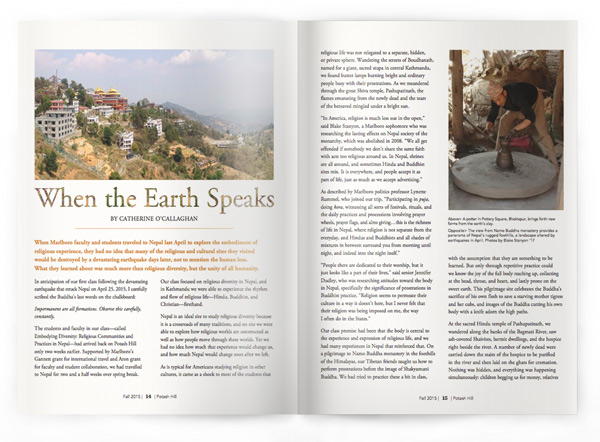
By Catherine O’Callahan
When Marlboro faculty and students traveled to Nepal last April to explore the embodiment of religious experience, they had no idea that many of the religious and cultural sites they visited would be destroyed by a devastating earthquake days later, not to mention the human loss. What they learned about was much more than religious diversity, but the unity of all humanity.
 In anticipation of our first class following the devastating earthquake that struck Nepal on April 25, 2015, I carefully scribed the Buddha’s last words on the chalkboard:
In anticipation of our first class following the devastating earthquake that struck Nepal on April 25, 2015, I carefully scribed the Buddha’s last words on the chalkboard:
Impermanent are all formations. Observe this carefully, constantly.
The students and faculty in our class—called Embodying Diversity: Religious Communities and Practices in Nepal—had arrived back on Potash Hill only two weeks earlier. Supported by Marlboro’s Gannett grant for international travel and Aron grant for faculty and student collaboration, we had travelled to Nepal for two and a half weeks over spring break. Our class focused on religious diversity in Nepal, and in Kathmandu we were able to experience the rhythm and flow of religious life—Hindu, Buddhist, and Christian—firsthand.
Nepal is an ideal site to study religious diversity because it is a crossroads of many traditions, and on site we were able to explore how religious worlds are constructed as well as how people move through these worlds. Yet we had no idea how much that experience would change us, and how much Nepal would change soon after we left.
As is typical for Americans studying religion in other cultures, it came as a shock to most of the students that religious life was not relegated to a separate, hidden, or private sphere. Wandering the streets of Boudhanath, named for a giant, sacred stupa in central Kathmandu, we found butter lamps burning bright and ordinary people busy with their prostrations. As we meandered through the great Shiva temple, Pashupatinath, the flames emanating from the newly dead and the tears of the bereaved mingled under a bright sun.
“In America, religion is much less out in the open,” said Blake Stanyon, a Marlboro sophomore who was researching the lasting effects on Nepal society of the monarchy, which was abolished in 2008. “We all get offended if somebody we don’t share the same faith with acts too religious around us. In Nepal, shrines are all around, and sometimes Hindu and Buddhist sites mix. It is everywhere, and people accept it as part of life, just as much as we accept advertising.”
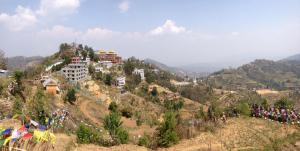 As described by Marlboro politics professor Lynette Rummel, who joined our trip, “Participating in puja, doing kora, witnessing all sorts of festivals, rituals, and the daily practices and processions involving prayer wheels, prayer flags, and alms giving…this is the richness of life in Nepal, where religion is not separate from the everyday, and Hindus and Buddhists and all shades of mixtures in between surround you from morning until night, and indeed into the night itself.”
As described by Marlboro politics professor Lynette Rummel, who joined our trip, “Participating in puja, doing kora, witnessing all sorts of festivals, rituals, and the daily practices and processions involving prayer wheels, prayer flags, and alms giving…this is the richness of life in Nepal, where religion is not separate from the everyday, and Hindus and Buddhists and all shades of mixtures in between surround you from morning until night, and indeed into the night itself.”
“People there are dedicated to their worship, but it just looks like a part of their lives,” said senior Jennifer Dudley, who was researching attitudes toward the body in Nepal, specifically the significance of prostrations in Buddhist practice. “Religion seems to permeate their culture in a way it doesn’t here, but I never felt that their religion was being imposed on me, the way I often do in the States.”
Our class premise had been that the body is central to the experience and expression of religious life, and we had many experiences in Nepal that reinforced that. On a pilgrimage to Namo Buddha monastery in the foothills of the Himalayas, our Tibetan friends taught us how to perform prostrations before the image of Shakyamuni Buddha. We had tried to practice these a bit in class, with the assumption that they are something to be learned. But only through repetitive practice could we know the joy of the full body reaching up, collecting at the head, throat, and heart, and lastly prone on the sweet earth. This pilgrimage site celebrates the Buddha’s sacrifice of his own flesh to save a starving mother tigress and her cubs, and images of the Buddha cutting his own body with a knife adorn the high paths.
At the sacred Hindu temple of Pashupatinath, we wandered along the banks of the Bagmati River, saw ash-covered Shaivites, hermit dwellings, and the hospice right beside the river. A number of newly dead were carried down the stairs of the hospice to be purified in the river and then laid on the ghats for cremation. Nothing was hidden, and everything was happening simultaneously: children begging us for money, relatives weeping for their dead, women doing laundry, children fishing, and music wafting through the smoky places. High above the river we were able to see rows of Shiva lingams, simple representations of the Hindu deity that are among the oldest religious symbols, reverberating in a line that seemed never to end.
When we visited Bhaktapur, an ancient Newar city known as Place of Devotees, with its labyrinthine alleys and tremendous South Indian temple architecture, we marveled at images from the Kama Sutra exquisitely carved into the Krishna temple. We were blessed with tikka head jewelry in the house of the Kumari, one of Nepal’s living goddesses. Around corners we saw women gathered by wells, bringing up water from the deep, and our guide pointed out a group of wailing women, saying that someone had just died at home. The potter’s square, full now with piggy banks for the tourist trade, was hot in the sun. Women bent over pots, setting them down ever so carefully. The clay—thought to be auspicious—emerges from the earth.
Exploring another strand in the complex weave of religious practice in Nepal, Marlboro junior Jonah Nonomaque collaborated with Lynette Rummel on research regarding conversion to Protestantism. “Very little research has been done on the growth of Christianity in Nepal, so I was eager to help fill this void while applying, testing, and enriching my own theoretical insights,” said Jonah, who has also studied Protestant conversion in upland Southeast Asia. “As an aspiring anthropologist, I found the opportunity to engage in fieldwork highly rewarding and challenging.”
Jonah and Lynette attended an evangelical church service that seemed to have no discernible beginning or end, and Lynette was even summoned to the pulpit by the pastor to give a short speech (including a “shout-out” to Marlboro College). The video presentation they made based on their experiences displayed worshippers slain in the spirit, a laying on of hands, a shaking body, and finally a worshipper in repose. The extreme physicality of the expression did not seem out of place among all we had seen so far in Kathmandu.
 We ascended the steps to the great Stupa of Svayambhu and explored a world where Buddhist and Hindu expression coexist and mutually celebrate each other. At the threshold of the shrine, with our students huddled round, Buddhist studies scholar Hubert Decleer retold the story of the Buddha’s enlightenment and how the very earth rose as witness. The Buddha’s classic pose— fingers touching the ground—evoked the earth goddess herself. As we entered the cavernous shrine to the earth goddess Vasudhara, vermillion powder flashing red on the well-rubbed deities among the flickering butter lamps, the earth—the home, the source, the wellspring, and the grave—was never more alive to me.
We ascended the steps to the great Stupa of Svayambhu and explored a world where Buddhist and Hindu expression coexist and mutually celebrate each other. At the threshold of the shrine, with our students huddled round, Buddhist studies scholar Hubert Decleer retold the story of the Buddha’s enlightenment and how the very earth rose as witness. The Buddha’s classic pose— fingers touching the ground—evoked the earth goddess herself. As we entered the cavernous shrine to the earth goddess Vasudhara, vermillion powder flashing red on the well-rubbed deities among the flickering butter lamps, the earth—the home, the source, the wellspring, and the grave—was never more alive to me.
Later in April the earth rose as witness once more. When the catastrophic earthquake struck Nepal, leaving over 9,000 dead, 23,000 injured, thousands homeless, and many UNESCO world heritage sites in ruins, I recited the Buddha’s last words to my class: “Impermanent are all formations. Observe this carefully, constantly.” I told the students that it was a practice of mine to memorize important texts, in the event that the paper, the stone, even the temples they are inscribed upon disappear. As, indeed, they will.
We shared our feelings of shock and helplessness in the wake of the disaster, the deadliest earthquake to hit Nepal on record. New friends did not turn up on Facebook; familiar sacred places had fallen; a country, whose weak infrastructure and poverty had been so evident to us, was now in crisis. I reminded the class of our first readings of the semester: the Bhagavad Gita. Many had wrestled with the text, the apparent fatalism of Krishna’s instructions to Arjuna, and Arjuna’s confusion.
 I am weighed down by pity, Krishna; my mind is utterly confused. Tell me where my duty lies, which path I should take.
I am weighed down by pity, Krishna; my mind is utterly confused. Tell me where my duty lies, which path I should take.
I ventured to suggest that Arjuna’s quandary was now ours: what is the correct response to such a vision, to such a horrific event, when the earth speaks with such violence? When Krishna reveals the universal form, Arjuna, although overwhelmed, resolves to perform his duty.
Arjuna saw the whole
Universe
Enfolded, with its countless
Billions
Of life-forms, gathered
Together
In the body of the God of gods.
Our students rallied, and held two auctions to raise funds to support earthquake relief efforts. Students donated items they had bought in Kathmandu and wonderful works from Marlboro’s many artists. We gave to the Earthquake Relief Fund at Shechen Monastery, because we had stayed in their guesthouse; we also contributed to Himalayan Roots to Fruits, who were our Tibetan “buddies,” as well as SEBS North America Nepal. Altogether the Marlboro community— students, alumni, staff, faculty, and trustees—mobilized to raise over $10,000 to send to Nepal.
“The money we raised is insignificant in the grand picture of things, but it is not insignificant: for we have been touched, and now we care deeply and personally,” said Lynette. “Events in Nepal are no longer just a story in the news. They are part of our lives. And while our efforts pale in comparison to the task of the rebuilding that lies ahead, what we have learned has made us more compassionate, more empathetic, more human.”
Our investigation of religious diversity, and our trip to Nepal in particular, taught us that no matter how far away and exotic other cultures are, we are all part of the same earth. And when the earth speaks, we will ask with Arjuna:
Teach me the way of worship
What it is, here, in the body.
Catherine O’Callaghan is assistant dean of academic advising at Marlboro College. She has a master of theological studies (MTS) in biblical studies from the Weston Jesuit School of Theology in Cambridge, Massachusetts, and a BA in English and theology from Fordham University.
Embodying Unchurched Spirituality Far from the crowded streets of Kathmandu, but with a similar purpose, Alex Bobella ’15 explored the importance of movement in spiritual belief for his Plan in religion and dance. He was specifically interested in religious beliefs existing outside of organized religion, loosely categorized as “unchurched” spirituality, and the work of contemporary artist Deborah Hay, whose choreography features a “focused inquiry into bodiliness.” “The body, according to Hay, is capable of forms and understandings that the conscious mind is not,” says Alex, who presented a Plan performance titled “A Catalogue of Non-Definitive Acts.” “Ever-present and constantly interpreting amorphous reality, while the analytical mind is caught in worry, the body surpasses the cognitive mind in contextualizing the self within the world. The body is a vessel for spiritual experience that celebrates a fundamental human quality—movement—and can be used in service of creating peak, almost transcendent, experiences.”
Far from the crowded streets of Kathmandu, but with a similar purpose, Alex Bobella ’15 explored the importance of movement in spiritual belief for his Plan in religion and dance. He was specifically interested in religious beliefs existing outside of organized religion, loosely categorized as “unchurched” spirituality, and the work of contemporary artist Deborah Hay, whose choreography features a “focused inquiry into bodiliness.” “The body, according to Hay, is capable of forms and understandings that the conscious mind is not,” says Alex, who presented a Plan performance titled “A Catalogue of Non-Definitive Acts.” “Ever-present and constantly interpreting amorphous reality, while the analytical mind is caught in worry, the body surpasses the cognitive mind in contextualizing the self within the world. The body is a vessel for spiritual experience that celebrates a fundamental human quality—movement—and can be used in service of creating peak, almost transcendent, experiences.”
True Colors
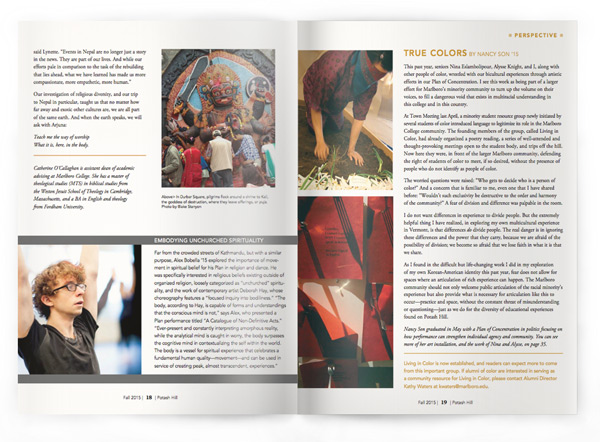
By Nancy Son ’15
This past year, seniors Nina Eslambolipour, Alysse Knight, and I, along with other people of color, wrestled with our bicultural experiences through artistic efforts in our Plan of Concentration. I see this work as being part of a larger effort for Marlboro’s minority community to turn up the volume on their voices, to fill a dangerous void that exists in multiracial understanding in this college and in this country.
At Town Meeting last April, a minority student resource group newly initiated by several students of color introduced language to legitimize its role in the Marlboro College community. The founding members of the group, called Living in Color, had already organized a poetry reading, a series of well-attended and thought-provoking meetings open to the student body, and trips off the hill. Now here they were, in front of the larger Marlboro community, defending the right of students of color to meet, if so desired, without the presence of people who do not identify as people of color.
The worried questions were raised: “Who gets to decide who is a person of color?” And a concern that is familiar to me, even one that I have shared before: “Wouldn’t such exclusivity be destructive to the order and harmony of the community?” A fear of division and difference was palpable in the room.
I do not want differences in experience to divide people. But the extremely helpful thing I have realized, in exploring my own multicultural experience in Vermont, is that differences do divide people. The real danger is in ignoring these differences and the power that they carry, because we are afraid of the possibility of division; we become so afraid that we lose faith in what it is that we share.
As I found in the difficult but life-changing work I did in my exploration of my own Korean-American identity this past year, fear does not allow for spaces where an articulation of rich experience can happen. The Marlboro community should not only welcome public articulation of the racial minority’s experience but also provide what is necessary for articulation like this to occur—practice and space, without the constant threat of misunderstanding or questioning—just as we do for the diversity of educational experiences found on Potash Hill.
Nancy Son graduated in May with a Plan of Concentration in politics focusing on how performance can strengthen individual agency and community. You can see more of her art installation, and the work of Nina and Alysse, on page 35.
Living in Color is now established, and readers can expect more to come from this important group. If alumni of color are interested in serving as a community resource for Living in Color, please contact Alumni Director Kathy Waters.
On and Off the Hill
Inaugurating a new president, welcoming a new theater professor, launching a new semester-long intensive, celebrating students who compose operas, compete in ski jumps, and check out more books from the library than any mortal could read. There's so many reasons to explore what's going on at Marlboro College.
A Culture of Gratitude: Kevin Quigley takes the helm
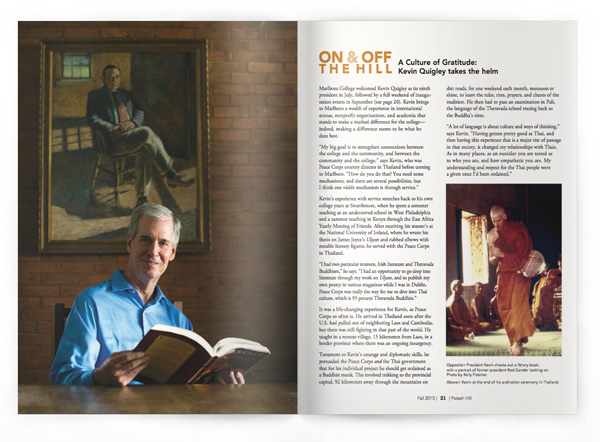
Marlboro College welcomed Kevin Quigley as its ninth president in July, followed by a full weekend of inauguration events in September (see page 20). Kevin brings to Marlboro a wealth of experience in international arenas, nonprofit organizations, and academia that stands to make a marked difference for the college—indeed, making a difference seems to be what he does best.
“My big goal is to strengthen connections between the college and the community, and between the community and the college,” says Kevin, who was Peace Corps country director in Thailand before coming to Marlboro. “How do you do that? You need some mechanisms, and there are several possibilities, but I think one viable mechanism is through service.”
Kevin’s experience with service stretches back to his own college years at Swarthmore, when he spent a semester teaching at an underserved school in West Philadelphia and a summer teaching in Kenya through the East Africa Yearly Meeting of Friends. After receiving his master’s at the National University of Ireland, where he wrote his thesis on James Joyce’s Ulysses and rubbed elbows with notable literary figures, he served with the Peace Corps in Thailand.
“I had two particular interests, Irish literature and Theravada Buddhism,” he says. “I had an opportunity to go deep into literature through my work on Ulysses, and to publish my own poetry in various magazines while I was in Dublin. Peace Corps was really the way for me to dive into Thai culture, which is 95 percent Theravada Buddhist.”
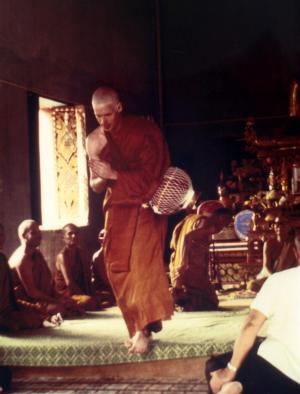 It was a life-changing experience for Kevin, as Peace Corps so often is. He arrived in Thailand soon after the U.S. had pulled out of neighboring Laos and Cambodia, but there was still fighting in that part of the world. He taught in a remote village, 15 kilometers from Laos, in a border province where there was an ongoing insurgency.
It was a life-changing experience for Kevin, as Peace Corps so often is. He arrived in Thailand soon after the U.S. had pulled out of neighboring Laos and Cambodia, but there was still fighting in that part of the world. He taught in a remote village, 15 kilometers from Laos, in a border province where there was an ongoing insurgency.
Testament to Kevin’s courage and diplomatic skills, he persuaded the Peace Corps and the Thai government that for his individual project he should get ordained as a Buddhist monk. This involved trekking to the provincial capital, 92 kilometers away through the mountains on dirt roads, for one weekend each month, monsoon or shine, to learn the rules, rites, prayers, and chants of the tradition. He then had to pass an examination in Pali, the language of the Theravada school tracing back to the Buddha’s time.
“A lot of language is about culture and ways of thinking,” says Kevin. “Having gotten pretty good at Thai, and then having this experience that is a major rite of passage in that society, it changed my relationships with Thais. As in many places, as an outsider you are tested as to who you are, and how empathetic you are. My understanding and respect for the Thai people were a given once I’d been ordained.”
Kevin’s service in Thailand altered how he thought of himself relative to the rest of humanity: he developed an abiding sense of compassion and, as they say in the Peace Corps, became at home in the world. It also gave him important skills he would use throughout his career and, perhaps most importantly, steeled his resolve to learn what was needed to make a difference.
“I saw what a raw deal my students and their parents got, and how they didn’t have access to resources. To someone who had done nothing but the humanities in college, it was an eye-opening experience—but like students here at Marlboro, I had also learned how to learn, and my time in Thailand motivated me to learn about economics and politics. I wanted to make things a little better for people like the villagers I worked with.”
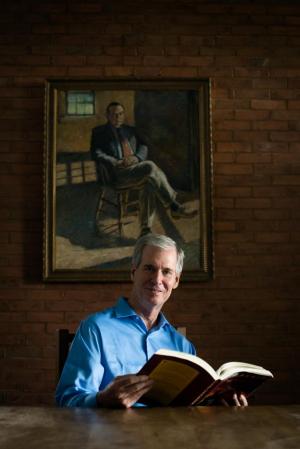 Kevin had an internship with the United Nations Development Program in Trinidad and Tobago, and earned his Master of International Affairs in economic and political development from Columbia University. Then, in Washington D.C., he oversaw foreign assistance agencies in President Reagan’s Office of Management and Budget and served as legislative director to U.S. Senator John Heinz, focusing on international financial and education issues. It was “a fabulous education inhow Washington and the world worked,” says Kevin, but the real watershed moment came in 1989, when he started as director of public policy at the Pew Charitable Trusts.
Kevin had an internship with the United Nations Development Program in Trinidad and Tobago, and earned his Master of International Affairs in economic and political development from Columbia University. Then, in Washington D.C., he oversaw foreign assistance agencies in President Reagan’s Office of Management and Budget and served as legislative director to U.S. Senator John Heinz, focusing on international financial and education issues. It was “a fabulous education inhow Washington and the world worked,” says Kevin, but the real watershed moment came in 1989, when he started as director of public policy at the Pew Charitable Trusts.
“It’s really rare in life that you can think of a problem or issue, and your first concern doesn’t have to be about resources,” says Kevin. “Although I hadn’t even heard of it before, at that time Pew was the second-largest foundation in the U.S., based on money out the door.” It was the end of the Soviet Union, the establishment of newly independent nations and economies in Central Europe, and all of the new leaders wanted access to Western ideas and resources. “Pew commanded the resources, so I got to meet many of the individuals, like Lech Walesa, Vaclav Havel, and others, who had a major impact on that democratization process.”
Following on his work in the former Soviet republics, Kevin published his book For Democracy’s Sake: Foundations and Democracy Assistance in Central Europe (Johns Hopkins University Press), in 1997. He was interested in how political and economic changes were effected, and what role outsiders have in encouraging or promoting such changes. Unlike after World War II, when the U.S. government helped rebuild Germany and Japan, there was no such appetite for public investment after the fall of the Berlin Wall. For better or worse, private foundations were the principal catalyst for change.
“I thought, this may be a completely unique experience in recent human history, a really interesting shift in what drives global change. I wanted to provide an opportunity for people at the forefront, leaders who were all so courageous, to assess what worked and what didn’t.” Kevin helped his colleagues in Czech Republic, Slovakia, Hungary, and Poland organize case studies in each country, providing financial and technical support, translating the results into their national language, and discussing them in public forums.
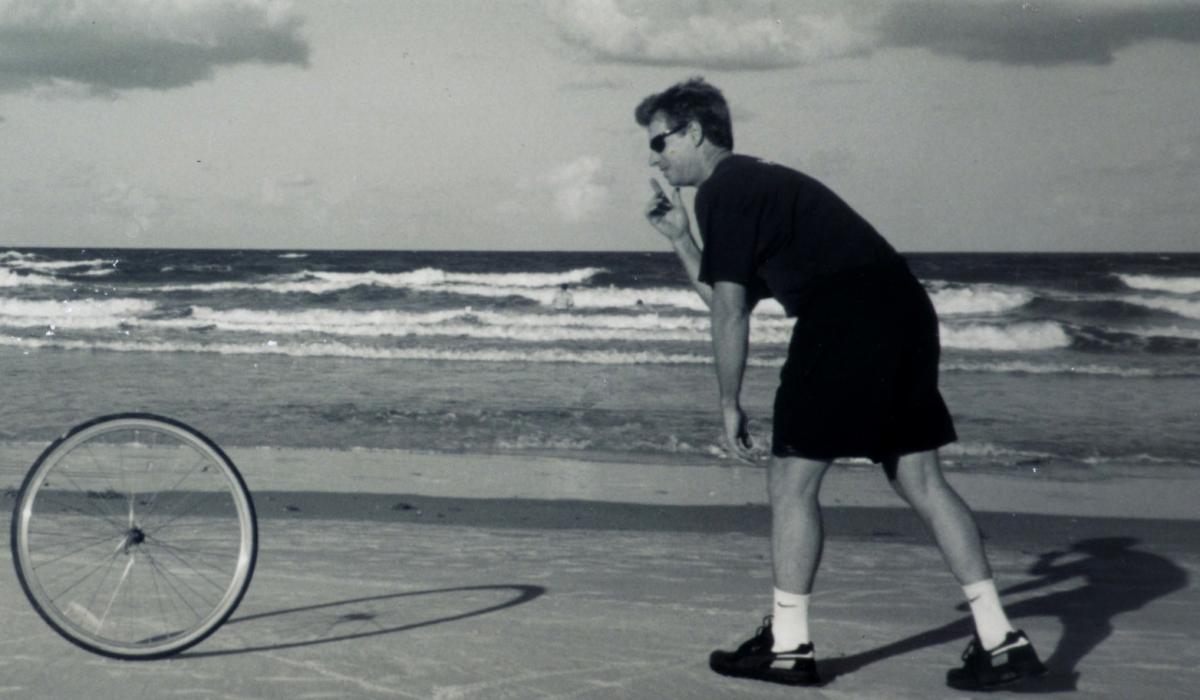 During his time at Pew, Kevin completed his doctoral degree in comparative government at Georgetown University. He wanted to conduct his own research on social change, but rather than focusing on Central Europe—where there might be conflicts of interest with his foundation work—he went back to Thailand. There he knew the language and culture, and was very familiar with the national challenges of democratization.
During his time at Pew, Kevin completed his doctoral degree in comparative government at Georgetown University. He wanted to conduct his own research on social change, but rather than focusing on Central Europe—where there might be conflicts of interest with his foundation work—he went back to Thailand. There he knew the language and culture, and was very familiar with the national challenges of democratization.
“I was particularly interested in the role that civil society organizations play in creating democratic culture. Because unless you have the values of democracy, you can create the best independent parliament, the freest press, and it’s not going to mean anything. You need a culture that respects minority rights; encourages tolerance, empathy, and patience; has accountability and transparency. So how do you create that? There are really three mechanisms: governmental, market, and civil society, that vital space between markets and the public sector.”
Kevin went on to serve as vice president for business and policy at the Asia Society and Museum, in New York, and the first executive director for the Global Alliance for Workers and Communities, based in Baltimore, Maryland. In the latter role, he pioneered work withglobal companies like Nike and The Gap, the World Bank, and various universities and community-based organizations, seeking to improve the lives of production workers. He also launched his own consulting firm, called Q&A: Quigley & Associates, working for values-based organizations on strategy, program development, and resource mobilization issues.
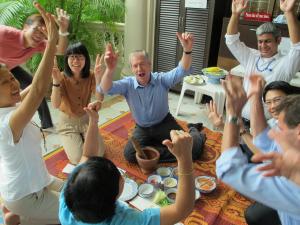 In 2003 Kevin came full circle, so to speak, and began nearly 10 years of service as president and CEO of the National Peace Corps Association (NPCA), the global alumni organization for 200,000 former volunteers and staff. There he developed a community-based model for the Peace Corps’ 50th anniversary, using social media to spark the largest engagement ever, and established the More Peace Corps Campaign, resulting in the highest appropriation in the agency’s history—a $60 million increase. He also helped secure passage of the Peace Corps Commemorative Act, signed into law by President Obama.
In 2003 Kevin came full circle, so to speak, and began nearly 10 years of service as president and CEO of the National Peace Corps Association (NPCA), the global alumni organization for 200,000 former volunteers and staff. There he developed a community-based model for the Peace Corps’ 50th anniversary, using social media to spark the largest engagement ever, and established the More Peace Corps Campaign, resulting in the highest appropriation in the agency’s history—a $60 million increase. He also helped secure passage of the Peace Corps Commemorative Act, signed into law by President Obama.
During his time at NPCA, Kevin designed and secured endowment funding for the Harris Wofford Global Citizen Award, which recognizes volunteers’ impact on individuals they serve. The award is named for one ofKevin’s mentors, Harris Wofford, the former senator, advisor to Martin Luther King Jr., and aide to President Kennedy, who was instrumental in the formation of the Peace Corps.
“Harris is kind of the godfather of service, in our country,” says Kevin, who has found inspiration in both Wofford and Sargent Shriver, statesman, activist, and the driving force behind the founding of the Peace Corps. “Both of them were always about the future. They were pragmatic idealists: they thought big, but could deliver, could make things happen to improve the lives of people.”
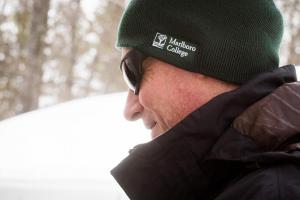 Throughout his career, Kevin has maintained a deep appreciation for and engagement with academia. He was a Woodrow Wilson Visiting Fellow at 12 liberal arts colleges from 2004 to 2012, and a faculty-practitioner graduate instructor teaching about international studies and nonprofit management from 1995 to 2011. Earlier, he was guest scholar at the Woodrow Wilson International Center for Scholars and the recipient of several other international professional fellowships. He has served on the board of Swarthmore College and the American University of Afghanistan.
Throughout his career, Kevin has maintained a deep appreciation for and engagement with academia. He was a Woodrow Wilson Visiting Fellow at 12 liberal arts colleges from 2004 to 2012, and a faculty-practitioner graduate instructor teaching about international studies and nonprofit management from 1995 to 2011. Earlier, he was guest scholar at the Woodrow Wilson International Center for Scholars and the recipient of several other international professional fellowships. He has served on the board of Swarthmore College and the American University of Afghanistan.
“Liberal arts education, especially in distinctive and academically rich settings such as Marlboro College, has a unique ability to anticipate change and prepare individuals for thoughtful, purposeful, and effective engagement in the world,” says Kevin. “What can you do with a liberal arts education? As my life suggests: anything and everything—it prepares you for a life unexpected.”
“For example, I’ve never had a course in economics and politics, and most of my life has been spent in those arenas. At its best, a liberal arts education stirs a passion for lifelong learning, looking at new opportunities as they come along, and making a difference. That’s what excites me, and that’s why I’m eager to make a contribution here at Marlboro.”
Kevin recognizes that Marlboro College is in a competitive environment, that small, independent, liberal arts colleges are under siege, and that many of them offer self-directed learning in small, interdisciplinary settings. But in his short time here so far he finds that what is most distinctive about Marlboro is the profound sense of community.
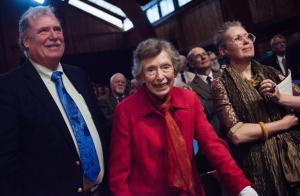 “Community has always been part of the ethos, and it’s reflected in the shared governance model. When people talk about shared governance in the liberal arts context, they’re talking about staff, faculty, and board—they’re not including students. While many liberal arts colleges share the objective of helping students become citizens of the world—and I’m a believer in experiential learning— I think Marlboro has a leg up because of our practices as a community.”
“Community has always been part of the ethos, and it’s reflected in the shared governance model. When people talk about shared governance in the liberal arts context, they’re talking about staff, faculty, and board—they’re not including students. While many liberal arts colleges share the objective of helping students become citizens of the world—and I’m a believer in experiential learning— I think Marlboro has a leg up because of our practices as a community.”
Kevin is looking forward to encouraging a more robust student life, including more activities on evenings and weekends and more interactions with local and global communities, as well as with the graduate campus in Brattleboro. “I see it in our culture, I see it in our heritage, but we have to have the programs that reflect the importance of community at Marlboro,” he says.
“I think of community as having shared values and experiences and aspirations. As community members we get opportunities and privileges, but we also have some responsibilities to other people. How do I express my gratitude at being a member of community? How do I fulfill part of my obligations? Service is a great way to do it, and it’s particularly powerful in an educational context, because service helps us learn life lessons and is the gift that keeps on giving.”
Celebrating President Kevin 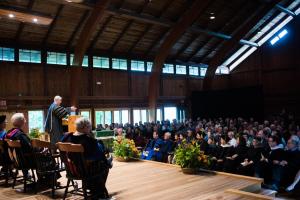 Students, faculty, staff, alumni, trustees, and friends from near and far gathered on September 13, 2015, for the inauguration of Dr. Kevin Quigley as Marlboro College’s ninth president. A drizzly day could not dampen spirits as the college community reveled in the celebration of Marlboro and its promising future under the guidance of President Kevin.
Students, faculty, staff, alumni, trustees, and friends from near and far gathered on September 13, 2015, for the inauguration of Dr. Kevin Quigley as Marlboro College’s ninth president. A drizzly day could not dampen spirits as the college community reveled in the celebration of Marlboro and its promising future under the guidance of President Kevin.
“Although change is never easy, Heraclitus, the Greek philosopher, teaches us that change is an entirely natural process since ‘no one steps into the same river twice,’” said Kevin in his inaugural address, titled “Marlboro Matters: The Engaged Marlboro Community of the Future.”
“The Marlboro of today is different from the Marlboro of yesterday and will be from the one of tomorrow. That river flows on, and we all must necessarily evolve with the flow. Our very engaged and amazingly supportive board has responded creatively and quickly to current challenges— again supporting how much Marlboro matters.
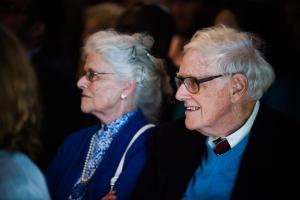 “Over the past few months, I have come to more deeply appreciate the fact that Marlboro matters because it continues to teach invaluable, timeless skills that have broad applicability: to think critically, to read closely, to communicate compellingly, to work in community.
“Over the past few months, I have come to more deeply appreciate the fact that Marlboro matters because it continues to teach invaluable, timeless skills that have broad applicability: to think critically, to read closely, to communicate compellingly, to work in community.
“Liberal arts, as the Greeks first posited, and as it is more recently argued by public intellectuals like Fareed Zakaria, is the best preparation for an engaged life and citizenship. As my life suggests, liberal arts graduates can do anything and everything, everywhere. There is also growing evidence from leading corporations, that they want liberal arts graduates because they work well across disciplines, problem solve, and communicate in ways that some other graduates can’t.”
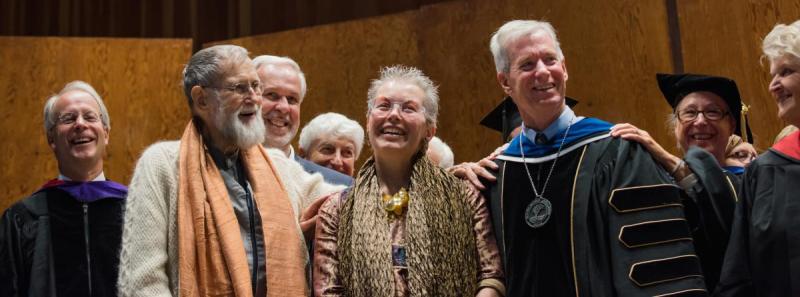 For more excerpts, photos, and video from the ceremony, go to marlboro.edu/inauguration.
For more excerpts, photos, and video from the ceremony, go to marlboro.edu/inauguration.
Semester intensive reframes addiction debate
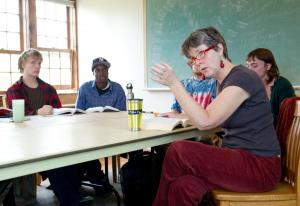 “With the recent spike in heroin overdoses in rural white America, addiction is getting a lot of attention,” says politics professor Meg Mott. “Governor Shumlin made it the sole concern of his 2014 State of the State Address. I thought it would be a good time to step back from the debate and look at how the speeches and campaigns were being framed.”
“With the recent spike in heroin overdoses in rural white America, addiction is getting a lot of attention,” says politics professor Meg Mott. “Governor Shumlin made it the sole concern of his 2014 State of the State Address. I thought it would be a good time to step back from the debate and look at how the speeches and campaigns were being framed.”
The result is Speech Matters, a new semester intensive launched by Meg this fall, which uses the humanities to delve deeply into and reframe a national issue, in this case addiction. Following the full-on, focused model pioneered by Movies from Marlboro, Speech Matters is taking one group of students through the political, economic, cultural, and racial aspects of addiction in America. In the process, each student is learning to communicate their ideas in nuanced but compelling ways and building a professional portfolio of blog posts, podcasts, op-eds, and other media content.
“The questions being posed in the current debate tend to ignore the larger structural reasons for drug use: in a town with no jobs, selling drugs is far more lucrative than panhandling,” says Meg. “In a nation with reduced social services, using drugs dulls the pain of losing custody of one’s child, not getting a callback on a job interview, or having to wait through the winter for a Section 8 voucher. By focusing on the ‘addict,’ we don’t look at the bad decisions made by policy makers, who often seem to be ruled by corporate interests.”
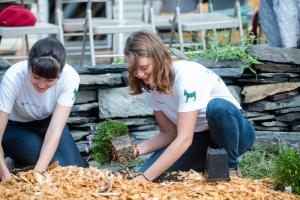 Meg draws inspiration for the Speech Matters program from her grandfather Archibald MacLeish, a librarian of congress, assistant secretary of state, and Pulitzer Prize–winning poet, who put as much emphasis on how things were said as on what was being said. “Archie spent enough time working for the government to know how speech could humanize or dehumanize a part of the population,” she says. “He got poet Ezra Pound out of St. Elizabeth’s mental hospital by arguing for the poet against claims that Pound was no more than a ‘crazy fascist.’”
Meg draws inspiration for the Speech Matters program from her grandfather Archibald MacLeish, a librarian of congress, assistant secretary of state, and Pulitzer Prize–winning poet, who put as much emphasis on how things were said as on what was being said. “Archie spent enough time working for the government to know how speech could humanize or dehumanize a part of the population,” she says. “He got poet Ezra Pound out of St. Elizabeth’s mental hospital by arguing for the poet against claims that Pound was no more than a ‘crazy fascist.’”
Students in Speech Matters will consider what it would look like to reframe addiction in human terms. “Instead of talking about people who use drugs as if they are deviant or different,” explains Meg, “critical theory asks us to consider who benefits from the creation of a class of ‘addicts.’” By investigating the history of drug policy and the cultural values embedded in the rhetoric of prevention, recovery, and treatment, Meg anticipates that more humanistic discussions of drug use will emerge.
“The most exciting thing for me is that we’ll be applying the skills of the humanities to an emerging political situation,” says Meg. “Right now, the 12-step programs are under scrutiny because of the Affordable Care Act, and ‘Big Pharma’ is moving in to support medication-assisted treatments. This is a very exciting time to think critically about who benefits from the existing narrative about addiction and what new, more community-based narratives might emerge.”
Jean O’Hara brings social change to theater
“I’m interested in how theater creates dialogue and new understandings,” says Jean O’Hara, who joined Brenda Foley as theater faculty last spring semester. Jean comes to Marlboro with two decades of teaching and directing experience, ten years in higher education, and a wealth of knowledge in areas of high interest to students, including political theater, environmental justice, and gender studies.
“Everything about Marlboro attracted me to Marlboro,” says Jean. “I love the fact that it has a smaller number of students, and that students have the freedom to choose what they want to study and take classes they are interested in—those are the best kind of students. At the same time, faculty can teach what they are passionate about— this is an amazing and rare opportunity as more and more universities are standardizing their curricula. I really love that Marlboro allows that freedom on both ends.”
Jean received her bachelor’s degree from Rhode Island College, her master’s from Humboldt State University, and her PhD from York University, with a dissertation that explores how two-spirit plays challenge the dominant narrative about gender and sexuality. She is also the editor of the anthology Two-Spirit Acts: Indigenous Queer Performances, and says that studying Indigenous societies has radically changed the way she views gender.
“Although I’ve been examining gender and gender politics for a long time, two-spirit scholarship radically shifted my worldview. The colonial tactics of annihilation of gender variance within Native communities was directly linked to the division of communally held land of Native nations. The communal system was replaced by individually owned property passed through the male bloodline. I believe we, both Native and non-Native people, are still living with the effects of this system, which created a binary and hierarchy between all genders.
Jean uses her work to investigate themes of racism, sexism, classism, ableism, transphobia, and heterosexism, and believes in the power and efficacy that theater has to give voice to traditionally marginalized groups. Having worked with both the San Francisco Mime Troupe and Augusto Boal’s Theater of the Oppressed, Jean credits Boal with laying the foundation for her own pedagogy, for seeing students as agents in the classroom. “We need to come from a place of equality in order to freely learn and create, versus working in hierarchical frameworks,” Jean says.
Jean is passionate about using theater as a venue for environmental justice, and for creating and maintaining local food sources. She co-edited and co-directed the play Salmon is Everything, which encouraged unity among farmers, ranchers, fishermen, and Native communities to all work for a cleaner river and healthy salmon runs in California and Oregon’s Klamath Basin.
“Having helped co-create Salmon is Everything, and bringing it out to reservations, really showed me the power of storytelling on another level,” says Jean. “To have non-Native community members and Native people from three different nations all working together to help keep the river healthy for everyone was really powerful. The play actually helped with that coalition— instead of all fighting for water, farmers and ranchers and fishermen and Native people were all looking at the bigger issue, which were the dams that stopped the flow of water. I’m proud that the play helped lead to legislation for those dams to come down.”
Last spring, Jean incorporated the community greenhouse into her class called Eco-Drama: Staging the Environment and Community, which culminated with harvesting their produce and making a meal combined with produce from other local farmers. She’s interested in local food and the slow food movement as a sustainable alternative to the present “megafood industry,” which is harmful to the land, animals, and workers.
This fall semester, Jean is offering two one-credit courses called Theater in the Wilds, which combine theater exercises with an outdoor adventure—a rafting trip and a backpacking trip, respectively. She is also collaborating with Spanish professor Rosario de Swanson to present Teatreras y Directoras, a course about Latin women who make theater and films exploring identity, family, citizenship, and class, among other topics.
“I see theater and storytelling as an important way to connect, build community, and create a much-neededto be heard,” she says. “I’m excited about co-creating with Brenda a really engaging theater program in the next few years. We are thrilled about our connection with the Vermont Performance Lab, and looking forward to incorporating Marlboro College theater more into the community.”
For Marlboro students interested in theater, Jean suggests exploring every aspect of the discipline, from playwriting to design, from acting to directing. “I think it’s really important for every theater artist to read and attend plays to expand how they view and present stories. She also suggests that students take risks in classes and on the stage. “Theater is such a gift of opening up your world and creating deep intimacy—it will change you in ways you never imagined.”
Also of Note
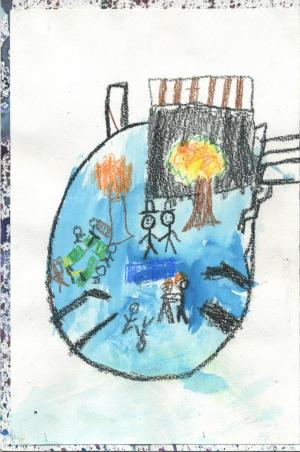 At the final Town Meeting last spring, the library announced that the annual “Check Me Out” Award, for checking out the most books in an academic year, went to Emily Tatro ’16. Emily smoked the opposition by taking out a stunning 103 books in the pursuit of her intellectual interests. While Marlboro College students take out an average of 52 books a year from the library, the national average for college students is 12.
At the final Town Meeting last spring, the library announced that the annual “Check Me Out” Award, for checking out the most books in an academic year, went to Emily Tatro ’16. Emily smoked the opposition by taking out a stunning 103 books in the pursuit of her intellectual interests. While Marlboro College students take out an average of 52 books a year from the library, the national average for college students is 12.
Louisa Jenness ’15 passed the highest level of the Hanyu Shuiping Kaoshi, a Chinese proficiency test for non-native Chinese speakers and the only international standardized exam recognized by the Republic of China. She passed level VI, which means she has a vocabulary of more than 5,000 characters and can effectively express herself both orally and on paper.
In February, sophomore Chris Lamb competed at the Harris Hill ski jumping competition in Brattleboro. Chris first competed at Harris Hill at the age of 11 and still holds the record for the longest jump there, at 102 meters, set in 2010. “It’s like learning how to ride a bike—you don’t forget,” said Chris. During the competition the announcers nicknamed him “the Professor,” because they saw him reading Immanuel Kant.
Benchmarks for a Better Vermont, a program of Marlboro’s Center for New Leadership (CNL), sponsored a training geared specifically for results-based accountability (RBA) trainers in April. Results expert Deitre Epps led the program, which was attended by a diverse group with deep experience in Vermont, and from as far away as Florida and Australia.
Theresa Chockbengboun ’15 (pictured right) was awarded a Fulbright U.S. Student Program grant to teach English at a university in Laos, while pursuing research opportunities in public health. “I’m excited to spend an entire year in another country and to learn about their culture and unique challenges in facing the future,” said Theresa. She did her Plan on public health in Southeast Asia, including an investigation of water quality and the use of “biosand” filters in Cambodian villages.
In April, seniors Edward Suprenant and Christian Lampart attended the Vermont Academy of Arts and Sciences Intercollegiate Student Symposium at Green Mountain College. Edward presented a paper about the tendency toward essentialism in historical studies of Buddhist traditions. “The idea that there is an essential practice or idea throughout history that is Buddhist is completely against the practices and ideas of Buddhism,” says Edward. Meanwhile, Christian presented a paper on Orthodox Christianity.
With support from a summer internship grant, senior Felix Jarrar spent his summer workshopping a new opera, The Fall of the House of Usher. Based on Edgar Allan’ Poe’s story by the same name, Felix’s opera tells the famed gothic tale from the perspective of Lady Madeline. The main project for his Plan of Concentration, the opera will be premiered next March at Marlboro and at the DiMenna Center in New York City. Learn more.
Events
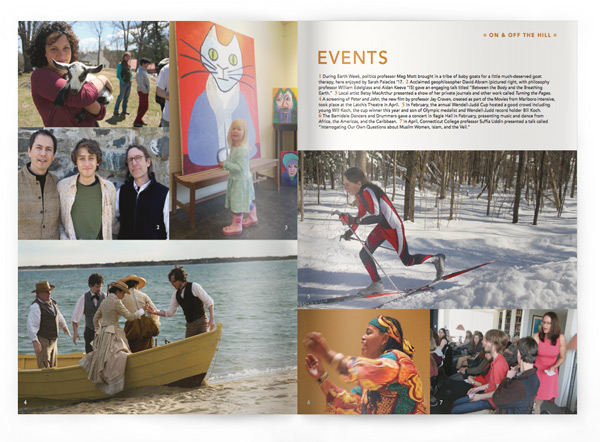
1 During Earth Week, politics professor Meg Mott brought in a tribe of baby goats for a little much-deserved goat therapy, here enjoyed by Sarah Palacios ’17. 2 Acclaimed geophilosopher David Abram (pictured right, with philosophy professor William Edelglass and Aidan Keeva ’15) gave an engaging talk titled “Between the Body and the Breathing Earth.” 3 Local artist Betsy MacArthur presented a show of her private journals and other work called Turning the Pages. 4 A screening of Peter and John, the new film by professor Jay Craven, created as part of the Movies from Marlboro intensive, took place at the Latchis Theatre in April. 5 In February, the annual Wendell-Judd Cup hosted a good crowd including young Will Koch, the cup winner this year and son of Olympic medalist and Wendell-Judd record holder Bill Koch. 6 The Bamidele Dancers and Drummers gave a concert in Ragle Hall in February, presenting music and dance from Africa, the Americas, and the Caribbean. 7 In April, Connecticut College professor Suffia Uddin presented a talk called “Interrogating Our Own Questions about Muslim Women, Islam, and the Veil."
Focus on Faculty
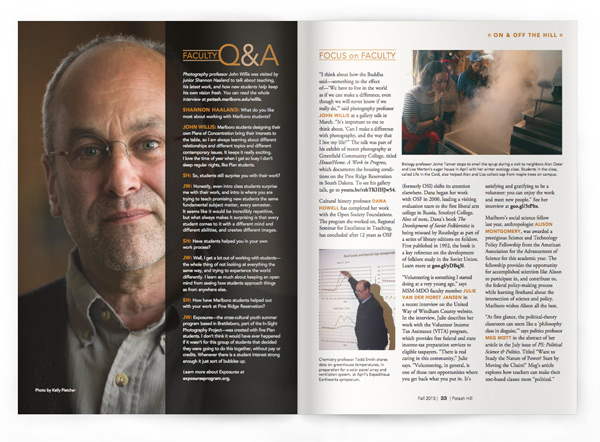
Faculty Q&A
Photography professor John Willis was visited by junior Shannon Haaland to talk about teaching, his latest work, and how new students help keep his own vision fresh. You can read the whole interview.
Shannon Haaland: What do you like most about working with Marlboro students?
John Willis: Marlboro students designing their own Plans of Concentration bring their interests to the table, so I am always learning about different relationships and different topics and different contemporary issues. It keeps it really exciting. I love the time of year when I get so busy I don’t sleep regular nights, like Plan students.
SH: So, students still surprise you with their work?
JW: Honestly, even intro class students surprise me with their work, and intro is where you are trying to teach promising new students the same fundamental subject matter, every semester. It seems like it would be incredibly repetitive, but what always makes it surprising is that every student comes to it with a different mind and different abilities, and creates different images.
SH: Have students helped you in your own work process?
JW: Well, I get a lot out of working with students— the whole thing of not looking at everything the same way, and trying to experience the world differently. I learn as much about keeping an open mind from seeing how students approach things as from anywhere else.
SH: How have Marlboro students helped out with your work at Pine Ridge Reservation?
JW: Exposures—the cross-cultural youth summer program based in Brattleboro, part of the In-Sight Photography Project—was created with five Plan students. I don’t think it would have ever happened if it wasn’t for this group of students that decided they were going to do this together, without pay or credits. Whenever there is a student interest strong enough it just sort of bubbles up.
Learn more about Exposures at exposuresprogram.org. Photo by Kelly Fletcher
Focus on Faculty
“I think about how the Buddha said—something to the effect of—‘We have to live in the world as if we can make a difference, even though we will never know if we really do,’” said photography professor John Willis at a gallery talk in March. “It’s important to me to think about, ‘Can I make a difference with photography, and the way that I live my life?’” The talk was part of his exhibit of recent photography at Greenfield Community College, titled House/Home: A Work in Progress, which documents the housing conditions on the Pine Ridge Reservation in South Dakota. See his gallery talk.
Cultural history professor Dana Howell has completed her work with the Open Society Foundations. The program she worked on, Regional Seminar for Excellence in Teaching, has concluded after 12 years as OSF (formerly OSI) shifts its attention elsewhere. Dana began her work with OSF in 2000, leading a visiting evaluation team to the first liberal arts college in Russia, Smolnyi College. Also of note, Dana’s book The Development of Soviet Folkloristics is being reissued by Routledge as part of a series of library editions on folklore. First published in 1992, the book is a key reference on the development of folklore study in the Soviet Union. Learn more.
“Volunteering is something I started doing at a very young age,” says MSM-MDO faculty member Julie van der Horst Jansen in a recent interview on the United Way of Windham County website. In the interview, Julie describes her work with the Volunteer Income Tax Assistance (VITA) program, which provides free federal and state income-tax preparation services to eligible taxpayers. “There is real caring in this community,” Julie says. “Volunteering, in general, is one of those rare opportunities where you get back what you put in. It’s satisfying and gratifying to be a volunteer: you can enjoy the work and meet new people.” See her interview.
Marlboro’s social science fellow last year, anthropologist Alison Montgomery, was awarded a prestigious Science and Technology Policy Fellowship from the American Association for the Advancement of Science for this academic year. The fellowship provides the opportunity for accomplished scientists like Alison to participate in, and contribute to, the federal policy-making process while learning firsthand about the intersection of science and policy. Marlboro wishes Alison all the best.
“At first glance, the political-theory classroom can seem like a ‘philosophy class in disguise,’” says politics professor Meg Mott in the abstract of her article in the July issue of PS: Political Science & Politics. Titled “Want to Study the Nature of Power? Start by Moving the Chairs!” Meg’s article explores how teachers can make their text-based classes more “political.” She considers how different teaching formats enact different types of power in the classroom, in turn necessitating political judgments. “By physicalizing the argumentative, introspective, and descriptive devices that writers of political theory use, students become better readers of these often old and usually dense texts,” says Meg. Read more.
In March, Chelsea Green Publishing released The Social Profit Handbook, by David Grant, faculty member in the Center for New Leadership’s Board Leadership Institute and Certificate in Nonprofit Management programs. The book offers those who lead, govern, and support mission-driven organizations and businesses new ways to assess their impact in order to improve future work, rather than merely judge past performance. Assessment doesn’t have to mean piles of quantitative data, says David, the former president and CEO of the Geraldine R. Dodge Foundation. “If you can describe it in words, you can measure it.”
“Marlboro College music professor Stan Charkey has written a new work, and it’s one that poignantly brings to life quiet moments from Vermont’s history,” writes Kari Anderson, managing producer for VPR Classical. Stan was interviewed by VPR in April regarding Vermont Headstones, his cycle of 12 songs for baritone, oboe, and viola that uses poetic inscriptions from historic Vermont cemeteries for the lyrics. The piece had its world premiere at Marlboro College last November, to glowing reviews. In April, Stan joined Kari to talk about what inspired Vermont Headstones, and the previously unsung Vermonters whose stories became songs. Read more.
“Vermont education pioneer John Dewey called for the ‘full participation with all our powers in the endeavor to wrest from each situation its own full meaning,’” says film and video studies professor Jay Craven. An award-winning independent filmmaker, co-founder of Kingdom County Productions, and director of the Movies from Marlboro semester intensive, Jay was invited to be the commencement speaker at Burlington College last May. He was also awarded an honorary degree in recognition of his contributions to the local and broader artistic communities. “Jay has opened the world of the arts and film to the citizens of the Kingdom and beyond,” says Burlington College President Carol Moore.
In May, visual arts faculty Cathy Osman and Tim Segar were featured in a group show at the Oxbow Gallery, in Northampton, Massachusetts. Titled Synecdoche: Simultaneous Understanding, the show included the work of eight Oxbow artists, and was curated by Deborra Stewart-Pettengill. For those unfamiliar with the term, synecdoche is a figure of speech similar to metonymy, in which a part is made to represent the whole, or vice versa. The Oxbow Gallery is a collective gallery owned and operated by 35 artist-members, showcasing a variety of fine art techniques and mediums.
And the winner is…Jim, Tim, and Todd. Computer science professor Jim Mahoney, visual arts professor Tim Segar, and chemistry professor Todd Smith were the proud winners of a LulzBot Mini v1.0 3D printer, as part of the first annual LulzBot Education Giveway sponsored by parent company Aleph Objects. The printer, which turns plastic filaments into three-dimensional shapes based on computer-aided designs, can be used by students in all areas of study. “We are excited to house the 3D printer in the new Snyder Center for the Visual Arts, which is intended for cross-disciplinary interaction,” said Todd. Kudos to campus store manager Rebecca Bartlett ’79 for alerting faculty to the competition.
“I cannot account for my mother. She is too many,” writes the inimitable literature and writing professor John Sheehy, who published a nonfiction story in the July/August issue of the online literary magazine Eclectica (Vol. 19, No. 3). Titled “To Thee Do WeCry,” John’s story reflects on the life and relationships of his mother, Rita, on the occasion of her funeral. John has previously published nonfiction in Fourth Genre, and had a story in the book The Good Men Project. Read his story.
In May, Karen White’s book Practical Project Management for Agile Nonprofits was awarded the bronze award for nonprofit books in the eighth annual Axiom Business Book Awards. Karen is a faculty member in the MSMMDO program and program chair for both the MSM in Health Care Management and MSM in Project Management programs. Karen’s second book, Practical Project Management offers useful approaches and templates for project managers to best maximize limited resources. “According to our publisher, it went up against books from some major publishing houses and was very well received for its practicality and applicability,” says Karen.
Last fall, Potash Hill reported that visual arts faculty members Cathy Osman, Tim Segar, and John Willis were launching a website and other efforts to support the Khmer Children’s Education Organization (KCEO), a family-run school in rural Cambodia. This year KCEO has been recognized with a commitment for ongoing assistance from the World Vision Organization, but they still need to raise their own percentage of the budget to receive this assistance. Cathy, Tim, John, and John’s wife, Pauline Brett, are on the school’s advisory board, and are encouraging other community members to help: even small donations can make a substantial difference. Learn more and contribute at khmerchildren.org.
In May, theater professors Jean O'Hara and Brenda Foley and junior Rainbow Stakiwicz participated in a weeklong residency with Spiderwoman Theater, the oldest Native women’s theater ensemble in North America. Based at the University of Oregon, the week of Indigenous-centered theater-making built upon Jean’s previous close collaborations with host Theresa May and Muriel Miguel, artistic director of Spiderwoman Theater. The residency showcased Indigenous theater as a medium to address Native communities’ relationship to rivers, while highlighting traditional environmental knowledge and understandings of sexuality and gender. In July, Jean collaborated again with Muriel Miguel on a Native theater intensive sponsored by the Centre for Indigenous Theatre.
Breaking out of unemployment and into a restaurant job in Brattleboro got easier this year, thanks to Tristan Toleno, faculty member in the MBA and MSM-MDO programs. Tristan was the resident chef for the “Farm to Plate” Culinary Apprenticeship Program, a 12-week program designed to lead to permanent food preparation positions and sponsored by the Strolling of the Heifers. The program offered its 12 participants basic food preparation skills from knife safety to culinary mathematics, management skills, job readiness skills, and on-the-job training in local restaurants and institutional kitchens. It was free to participants who met income and employment status qualifications, including veterans.
Student Art
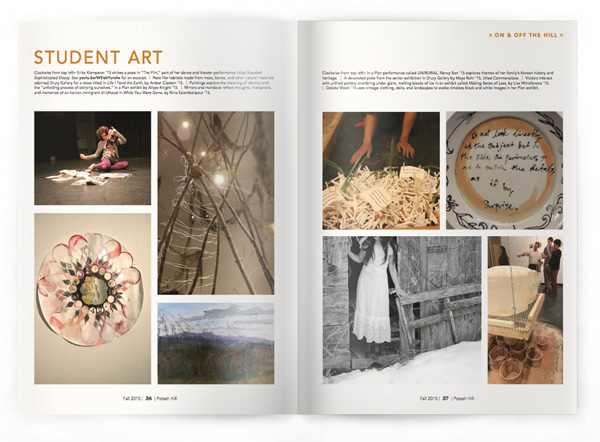
Left page, clockwise from top left> Erika Klemperer ’15 strikes a pose in “The Flirt,” part of her dance and theater performance titled Slapdash Sophisticated Doozy. See youtu.be/W5IekYurolw for an excerpt. | Nest-like habitats made from moss, bones, and other natural materials adorned Drury Gallery for a show titled In Life I Tend the Earth, by Amber Claxton ’15. | Paintings explore the meaning of identity and the “unfolding process of storying ourselves,” in a Plan exhibit by Allyse Knight ’15. | Mirrors and mandalas reflect thoughts, metaphors, and memories of an Iranian immigrant childhood in While You Were Gone, by Nina Eslambolipour ’15.
Right page, clockwise from top left> In a Plan performance called UN/BURIAL, Nancy Son ’15 explores themes of her family’s Korean history and heritage. | A decorated plate from the senior exhibition in Drury Gallery by Maya Rohr ’15, titled Commonplace. | Visitors interact with unfired pottery crumbling under giant, melting blocks of ice in an exhibit called Making Sense of Loss, by Liza Mitrofanova ’15. | Dakota Walsh ’15 uses vintage clothing, dolls, and landscapes to evoke timeless black and white images in her Plan exhibit.
2015 Undergraduate Commencement
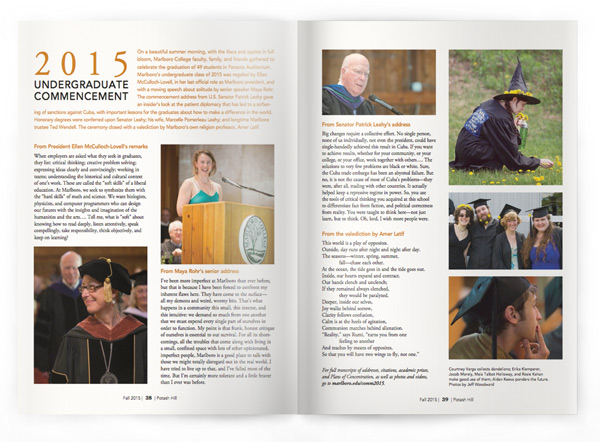
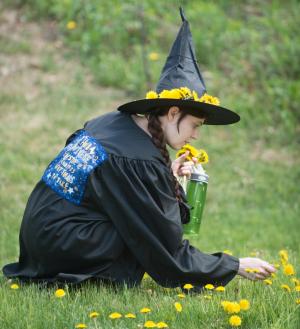 On a beautiful summer morning, with the lilacs and apples in full bloom, Marlboro College faculty, family, and friends gathered to celebrate the graduation of 49 students in Persons Auditorium. Marlboro’s undergraduate class of 2015 was regaled by Ellen McCulloch-Lovell, in her last official role as Marlboro president, and with a moving speech about solitude by senior speaker Maya Rohr. The commencement address from U.S. Senator Patrick Leahy gave an insider’s look at the patient diplomacy that has led to a softening of sanctions against Cuba, with important lessons for the graduates about how to make a difference in the world. Honorary degrees were conferred upon Senator Leahy; his wife, Marcelle Pomerleau Leahy; and longtime Marlboro trustee Ted Wendell. The ceremony closed with a valediction by Marlboro’s own religion professor, Amer Latif.
On a beautiful summer morning, with the lilacs and apples in full bloom, Marlboro College faculty, family, and friends gathered to celebrate the graduation of 49 students in Persons Auditorium. Marlboro’s undergraduate class of 2015 was regaled by Ellen McCulloch-Lovell, in her last official role as Marlboro president, and with a moving speech about solitude by senior speaker Maya Rohr. The commencement address from U.S. Senator Patrick Leahy gave an insider’s look at the patient diplomacy that has led to a softening of sanctions against Cuba, with important lessons for the graduates about how to make a difference in the world. Honorary degrees were conferred upon Senator Leahy; his wife, Marcelle Pomerleau Leahy; and longtime Marlboro trustee Ted Wendell. The ceremony closed with a valediction by Marlboro’s own religion professor, Amer Latif.
From President Ellen McCulloch-Lovell’s remarks
When employers are asked what they seek in graduates, they list: critical thinking; creative problem solving; expressing ideas clearly and convincingly; working in teams; understanding the historical and cultural context of one’s work. These are called the “soft skills” of a liberal education. At Marlboro, we seek to synthesize them with the “hard skills” of math and science. We want biologists, physicists, and computer programmers who can design our futures with the insights and imagination of the humanities and the arts…. Tell me, what is “soft” about knowing how to read deeply, listen attentively, speak compellingly, take responsibility, think objectively, and keep on learning?
From Maya Rohr’s senior address 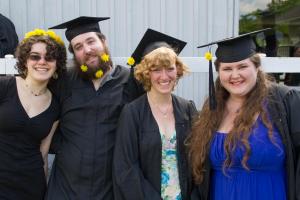 I’ve been more imperfect at Marlboro than ever before, but that is because I have been forced to confront my inherent flaws here. They have come to the surface— all my demons and weird, wormy bits. That’s what happens in a community this small, this intense, and this intuitive: we demand so much from one another that we must expend every single part of ourselves in order to function. My point is that frank, honest critique of ourselves is essential to our survival. For all its shortcomings, all the troubles that come along with living in a small, confined space with lots of other opinionated, imperfect people, Marlboro is a good place to talk with those we might totally disregard out in the real world. I have tried to live up to that, and I’ve failed most of the time. But I’m certainly more tolerant and a little braver than I ever was before.
I’ve been more imperfect at Marlboro than ever before, but that is because I have been forced to confront my inherent flaws here. They have come to the surface— all my demons and weird, wormy bits. That’s what happens in a community this small, this intense, and this intuitive: we demand so much from one another that we must expend every single part of ourselves in order to function. My point is that frank, honest critique of ourselves is essential to our survival. For all its shortcomings, all the troubles that come along with living in a small, confined space with lots of other opinionated, imperfect people, Marlboro is a good place to talk with those we might totally disregard out in the real world. I have tried to live up to that, and I’ve failed most of the time. But I’m certainly more tolerant and a little braver than I ever was before.
From Senator Patrick Leahy’s address
Big changes require a collective effort. No single person, none of us individually, not even the president, could have single-handedly achieved this result in Cuba. If you want to achieve results, whether for your community, or your college, or your office, work together with others…. The solutions to very few problems are black or white. Sure, the Cuba trade embargo has been an abysmal failure. But no, it is not the cause of most of Cuba’s problems—they were, after all, trading with other countries. It actually helped keep a repressive regime in power. So, you use the tools of critical thinking you acquired at this school to differentiate fact from fiction, and political correctness from reality. You were taught to think here—not just learn, but to think. Oh, lord, I wish more people were.
From the valediction by Amer Latif 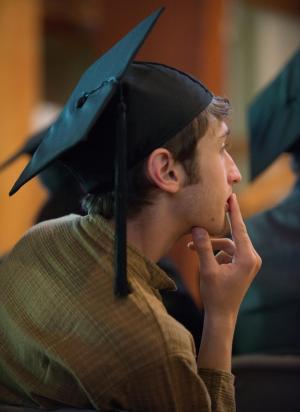 This world is a play of opposites.
This world is a play of opposites.
Outside, day runs after night and night after day.
The seasons—winter, spring, summer, fall—chase each other.
At the ocean, the tide goes in and the tide goes out.
Inside, our hearts expand and contract.
Our hands clench and unclench;
If they remained always clenched, they would be paralyzed.
Deeper, inside our selves,
Joy walks behind sorrow,
Clarity follows confusion,
Calm is at the heels of agitation,
Communion marches behind alienation.
“Reality,” says Rumi, “turns you from one feeling to another
And teaches by means of opposites,
So that you will have two wings to fly, not one.”
Find full transcripts of addresses, citations, academic prizes, and Plans of Concentration, as well as photos and videos, on the website.
Alumni News
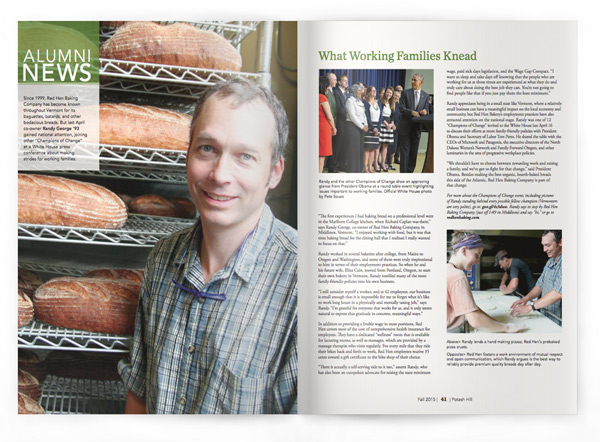
What Working Families Knead
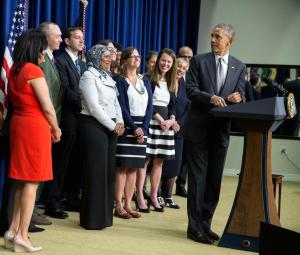 Since 1999, Red Hen Baking Company has become known throughout Vermont for its baguettes, batards, and other bodacious breads. But last April co-owner Randy George ’93 gained national attention, joining other “Champions of Change” at a White House press conference about making strides for working families.
Since 1999, Red Hen Baking Company has become known throughout Vermont for its baguettes, batards, and other bodacious breads. But last April co-owner Randy George ’93 gained national attention, joining other “Champions of Change” at a White House press conference about making strides for working families.
“The first experiences I had baking bread on a professional level were in the Marlboro College kitchen, when Richard Caplan was there,” says Randy George, co-owner of Red Hen Baking Company, in Middlesex, Vermont. “I enjoyed working with food, but it was that time baking bread for the dining hall that I realized I really wanted to focus on that.”
Randy worked in several bakeries after college, from Maine to Oregon and Washington, and some of them were truly inspirational to him in terms of their employment practices. So when he and his future wife, Eliza Cain, moved from Portland, Oregon, to start their own bakery in Vermont, Randy instilled many of the most family-friendly policies into his own business.
“I still consider myself a worker, and at 42 employees, our business is small enough that it is impossible for me to forget what it’s like to work long hours in a physically and mentally taxing job,” says Randy. “I’m grateful for everyone that works for us, and it only seems natural to express that gratitude in concrete, meaningful ways.”
In addition to providing a livable wage in most positions, Red Hen covers most of the cost of comprehensive health insurance for employees. They have a dedicated “wellness” room that is available for lactating moms, as well as massages, which are provided by a massage therapist who visits regularly. For every mile that they ride their bikes back and forth to work, Red Hen employees receive 35 cents toward a gift certificate to the bike shop of their choice.
“There is actually a self-serving side to it too,” asserts Randy, who has also been an outspoken advocate for raising the state minimum wage, paid sick days legislation, and the Wage Gap Compact. “I want to sleep and take days off knowing that the people who are working for us at those times are experienced at what they do and truly care about doing the best job they can. You’re not going to find people like that if you just pay them the bare minimum.”
Randy appreciates being in a small state like Vermont, where a relatively small business can have a meaningful impact on the local economy and community, but Red Hen Bakery’s employment practices have also attracted attention on the national stage. Randy was one of 12 “Champions of Change” invited to the White House last April 16 to discuss their efforts at more family-friendly policies with President Obama and Secretary of Labor Tom Perez. He shared the table with the CEOs of Microsoft and Patagonia, the executive directors of the North Dakota Women’s Network and Family Forward Oregon, and other luminaries in the area of progressive workplace policies.
“We shouldn’t have to choose between rewarding work and raising a family, and we’ve got to fight for that change,” said President Obama. Besides making the best organic, hearth-baked breads this side of the Atlantic, Red Hen Baking Company is part of that change.
For more about the Champions of Change event, including pictures of Randy standing behind every possible fellow champion (Vermonters are very polite), go to the White House blog. Randy says to stop by Red Hen Baking Company (just off I-89 in Middlesex) and say “hi,” or go to redhenbaking.com.
Class Notes
Class notes are listed by year and include both graduates and nongraduates; the latter are listed under the class with which they are associated.
’60
PENNY SAYRE WIEDERHOLD mourns the loss of her husband, Michael, in January 2015. “I am traveling and involved in our symphony and several chamber music groups—as an educator, not a player,” writes Penny. “Your publications are excellent.”
’63
“Preparing to direct Goldoni’s Servant of Two Masters for the Midcoast Actor’s Studio, located in Belfast, Maine,” writes JONATHAN POTTER. “Just had some poetry published, and my novel We Will What We Will is doing well. Working on a poetry book with friends. Looking forward to rowing and sailing.”
’68
“Enjoy reading Potash Hill,” writes MARK KLIMO. “Keep up the good work and communication. Always have fond memories of my formative years at Marlboro, 1964 to ’68.”
’70 “It was a fertile time,” said JOEY KLEIN, who participated in a Vermont Historical Society forum on the state’s cultural renaissance in the 1970s, as reported in the May 4 Times Argus. Joey describes it as a period when energetic people looking for grounding in life encountered native Vermonters, who already were grounded. “Some folks scowled at us and some folks were amused by us.” Joey lives in Plainfield, where he and his wife, Betsy Ziegler, own Littlewood Farm.
’72
“A lot of changes in the Gerzina household,” writes GRETCHEN GERZINA. “Anthony and I have left Vermont, and I am leaving Dartmouth College: I have been appointed the dean of the Commonwealth Honors College, at the University of Massachusetts, Amherst. It is an exciting change, although it’s been challenging to downsize from a 250-year-old farmhouse with 12 acres and 2 barns to a smaller place in Northampton. The new job is also a new challenge and wonderful opportunity. We’ll now be closer to our son Simon and his family (including our two grandchildren) in Brooklyn; our son Daniel remains in Chicago. I remain a member of Marlboro’s board of trustees, and so Vermont will remain a part of my life.”
“A member of the class of 1972, you first came to Marlboro to study Italian literature, poetry, translation, and MICHELLE CHASSE ’73, not necessarily in that order,” reads the honorary degree citation for DAVID HOLZAPFEL. David received a Doctor of Humane Letters from Marlboro on the occasion of his retirement celebration in the dining hall in June.
’75
In March, KATIE KRAMER appeared on campus for a reading of selections from her work, including her new memoir, Missing History: The Covert Education of a Child of the Great Books. Katie is a visiting assistant professor of English and American literature at Middlebury College.
’76
“My husband, one of our daughters, and I just returned from a trip to Osaka and Kyoto, Japan,” writes MELISSA METTLER ABRAMS. “It was a business trip, but we managed to include some sightseeing as well. We were lucky to see the cherry blossoms in full bloom. My older daughter is graduating from the School of the Art Institute of Chicago in May, so we will all be there for that. My younger daughter will be finishing up her freshman year at San Diego State University.”
Smarter on Crime: Scott Williams ’93 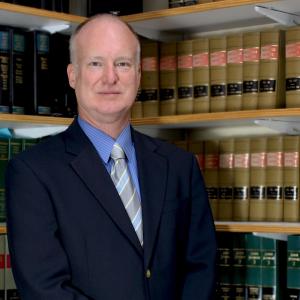 Last November, Scott Williams defeated the incumbent Republican for the position of Vermont state’s attorney in Washington County. He won the office on a campaign of striving to be “smarter on crime,” playing an active leadership role in law enforcement, and ensuring that victims are given a better “voice” in the criminal court system.
Last November, Scott Williams defeated the incumbent Republican for the position of Vermont state’s attorney in Washington County. He won the office on a campaign of striving to be “smarter on crime,” playing an active leadership role in law enforcement, and ensuring that victims are given a better “voice” in the criminal court system.
“I am working to bring others, and particularly government decision makers, to realize that responding to crime as a public health issue is, in the long run, a more effective approach than the traditional ‘law enforcement’ model,” says Scott. “My staff and I are trying to create space within which we will seek to build efficient and smart structures for how our community as a whole responds to crime.”
A graduate of Temple University Law School, Scott brings a wealth of experience to his new job, with almost 20 years practicing law, most recently in his own firm, Williams & Gray. He says he is well suited to his position because he enjoys working with people, and he realizes the value of collaborative work, but he’s also comfortable being “the boss.” Perhaps more importantly, he has a profound sense of humanity. “As a former defense attorney, I am aware of and empathetic to the reality of so many people charged with crimes, people for whom we, as a society, seem to have lost any sense of forgiveness.”
When he is not lawyering, Scott loves being with his family, skiing, and of course running a chain saw. He still loves to read, often four books at once: “the Kindle is Satan’s spawn,” he says. “For years I have pitched to anyone who would listen the value of a Marlboro education. Not only the willingness to question but the typically unavoidable questioning of the existing paradigm.”
’80
ANNIE QUEST writes, “Had a lovely dinner and mini reunion at Panda North in Brattleboro, Vermont, with JAY DAVIS ’79, LINDY WHITON ’77, MATT SKEELE ’79, Emma Worth (daughter of DIANE KAZER WORTH), and friends to celebrate a visit from Lindy’s nephew Jason. Also in attendance was our 9-month-old grandson. What a joyful gathering.”
OLGA PAREDES writes, “I’m still mediating child custody disputes at superior court in Alameda County and am still loving the work. When not at work I can be found in my garden with Leo the wonder dog. Regards to all at Marlboro, especially CHRIS DEWART ’78.”
’82
DAVID SKEELE writes, “Still happily employed at Slippery Rock University, in Pennsylvania, teaching acting and playwriting and directing lots of shows. Currently I’m hard at work on a TV pilot script and an iambic pentameter political thriller/rock musical.”
DANIEL PICKER is the author of a new scholarly article, “Incredible Diligence,” in the Spring 2015 issue of the Sewanee Review. “The article discusses Updike, on the life and work of John Updike, which includes his life in Vermont. I’m also the author of a new short story that appears in the fiction section of the Spring 2015 issue of the Abington Review. I correspond on occasion with Marlboro historian DAN TOOMEY ’79, Native American and Irish scholar JIM WADE, as well as INGRID AUFDERHEIDE CARLSON, TIM PRATT, PHIL HALL ’81, BEN SARGENT ’83, and Tom Ragle, former president.
’83
“I wish Jim Tober a happy retirement,” writes XENIA WILLIAMS. “I recall struggling through Jim’s 9:00 a.m. statistics class, preceded by the 8:00 a.m. math for numerically challenged stats students. My current math problem is living on social security.”
’85
RACHEL BERESON LACHOW writes, “My high school (Audubon Expedition Institute [now known as EEI]) has merged with my college. Mind blowing. Good luck to Ellen.”
’86
CHARLES CURTIN is pleased to announce the publication of his new book, The Science of Open Spaces, recently out from Island Press. “The book chronicles two decades of work in conservation, spanning marine and terrestrial systems, and spans international and North America projects,” writes Charles.
’87
JENNIFER WEST writes, “In June, I won the contest to design the burgee and logo for the newly formed Steamboat Springs Yacht Club. I’m in the process of organizing a group called Sketch Steamboat Springs, an informal, friendly sketching group for all levels and ages. The idea is that we go on 'Sketchcrawls' (like pub crawls but with sketchbooks instead of Guinness)."
KIMBERLY DOW became chief of academics at the innovative U.S. Performance Academy, a digital, independent school for competitive athletes in middle and high school. “Our passion is to create a personalized learning plan that is both flexible and balanced, and which offers opportunities to build collaborative environments among elite athletes in many different sports around the world,” says Kim, who will lead the school’s academic operations from Lake Placid, New York.
Entrepreneurship as a Way of Life: HeatherJean MacNeil ’02 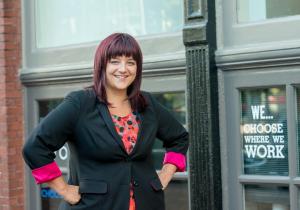 A self-described “start-up junkie,” HeatherJean MacNeil launched her first venture, an ethical fashion company called Proxy Apparel, in 2008 (see Potash Hill, Summer 2009). Since then she has joined the team at the Center for Women’s Entrepreneurial Leadership, at Babson College, where she founded a women’s accelerator program called the Women Innovating Now (WIN) Lab.
A self-described “start-up junkie,” HeatherJean MacNeil launched her first venture, an ethical fashion company called Proxy Apparel, in 2008 (see Potash Hill, Summer 2009). Since then she has joined the team at the Center for Women’s Entrepreneurial Leadership, at Babson College, where she founded a women’s accelerator program called the Women Innovating Now (WIN) Lab.
“I love working with women founders and start-ups,” says HeatherJean, whose experience launching Proxy opened her eyes to gender biases for entrepreneurs. “I’m very passionate about closing the gender gap in entrepreneurship. The WIN Lab has become my outlet to design and test possible solutions and educational models that could change the landscape for women founders and CEOs.”
The WIN Lab is a nine-month, customized program for women entrepreneurs (that’s right, WINners) to test, launch, and grow high-potential, high-impact ventures. The program is rigorous, milestone-driven, and recognized by the U.S. Association for Small Business and Entrepreneurship as an outstanding specialty entrepreneurship program. Last December, the WIN Lab received BostInno’s “50 on Fire” award for cutting-edge educational programming.
“I love working in Boston’s start-up scene, and being around creative people executing on their ideas, problem-solving, and being bold,” says HeatherJean, but she can still wax nostalgic about Potash Hill. “My Marlboro friends are for life, and the most talented, audacious people I know. The pressing questions of my Marlboro professors are still like a bug in my ear, and they continue to sponsor my ongoing ‘Plan’ in life. Marlboro teaches you to write and find your voice, and I have always found this to be a competitive advantage.”
HeatherJean is starting a fulltime doctoral program in entrepreneurship and strategy at Bentley University this fall, and will be working to scale the WIN Lab globally. For more information, go to thewinlab.org.
’90
“My first novel, Hidden View, will be published by Green Writers Press of Brattleboro this coming fall,” writes BRETT ANN STANCIU. “I was at my niece’s graduation in May 2014, and it was such a pleasure to see Marlboro looking so fine. Furthermore, ANDREW DELBANCO’s speech reminded me all over again just why I am so fortunate to have attended this great college.”
’91
After visiting campus last spring with her husband, HAYDAN BAKER ’92, and daughter, a prospective student, JUDY-GAIL HOUSER BAKER shared this reminiscence of coming to Marlboro, the first in her family to graduate from high school, let alone college. “It’s probably cliché to admit that my life’s path was set here. A lesson in my World History class that began with ‘write down everything you know about the Middle East—you have five minutes’ (I was thoroughly disgusted with my limited knowledge—no, seriously, camels, oil, desert...limited) led to: self-studying Arabic; diving deep into multicultural literature; interning in Jordan; writing a Plan with Birje (my spirit father) and Tim Little; going to grad school to pick up five more languages and figure out the existing barriers to real teaching outside of oases like Marlboro; becoming a high school humanities teacher and a college and high school writing prof; and now getting ready to take on a PhD in English, examining the concept of authentic teaching and learning of academic writing. Now, when someone tells me that a particular kid or group of kids isn’t ‘my’ caliber of student, I think: Yes. Bring ’em on!”
’92
A professor of Music at Ashland University, in Ashland, Ohio, CHRISTINA FUHRMANN received the 2015 Taylor Excellence in Teaching Award medal during AU’s academic honors convocation in April. Christina’s research focuses on theater music and imported opera in early 19th-century London. Referring to her Plan sponsor, Luis Batlle, Christina says, “Luis was one of the most inspiring teachers (and people) I have had the pleasure to work with.”
ALEX GARDNER makes a timely appearance on the Lambda Legal promotional video called “Say #IDO to Equality,” supporting the LGBT rights movement leading up to the historic Supreme Court ruling in June and beyond. “I do because it would be a huge step toward equal rights in America,” says Alex.
’93
CATE MARVIN is having quite a year. Her new book of poems, Oracle, was published by W. W. Norton in March, and she was awarded a Guggenheim fellowship. In her spare time, Cate spearheaded the Jed Fels ’92 memorial prize, raising over $12,000 from some 80 donors.
Art imitating life? SEAN COLE has a cameo performance in the recent movie Learning to Drive, with Ben Kingsley and Patricia Clarkson, where he plays a radio interviewer. In real life, Sean is one of the producers for the popular public radio show This American Life. You can hear his familiar voice at the beginning of the trailer.
JODI CLARK MSM-MDO ‘15 was chosen one of the 100 most stylish dapperQs for 2015, demonstrating that even in Vermont you can find the perfect suit. In Jodi’s case, this is a three-piece Mantoni.
’96
TRAVIS STEVENS was producer on the recent horror film We Are Still Here, which one reviewer called “a wildly original and terrifyingly entertaining ride, sure to be the most memorable genre film of the year."
’98
“All is well here in Ohio,” writes NORA DANIEL. “Ruby is 8 and thriving. Paul and I are working toward upcoming shows.”
’99
“Hi Marlboro,” writes JUNIPER KATZ. “I’m back in school again as a PhD student at University of Colorado Denver, in the school of public affairs.”
CHARLIE BARMONDE organized a group show featuring generations of Marlboro ceramics artists for March’s annual conference of the National Council on Education for the Ceramic Arts, in Providence, Rhode Island. Titled From Potash, the show featured artists MALCOLM (ORV) WRIGHT ’80, ELLEN SCHON ’75, and WILSON GAUL ’10, along with visual arts professor Tim Segar, students, and former faculty members.
“My work revolves around buildings because they encompass everything I think is important about sculpture,” says CHRIS OLIVER in an article about his spring exhibit at the Community School of Music and Arts in Ithaca, New York. “Buildings are at once timeless and so serious, such a basic human need, and can also be such hilarious exhibitors of human tastes.”
Outsmarting Brain Cancer: Tenley Archer ’03 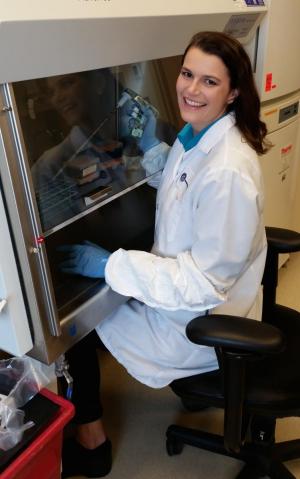 “I have found that my experience at Marlboro scales to other projects,” says Tenley Archer. “The Plan gave me a solid experience in completing a big project, and made it less daunting to do it again, and again.” Following her Plan on developmental cell biology, Tenley started graduate school in the lab of her outside examiner, Elena Casey, at Georgetown University. Having completed her PhD with a dissertation on the role of transcription factors in neural development, she is now doing postdoctoral research at Boston Children’s Hospital.
“I have found that my experience at Marlboro scales to other projects,” says Tenley Archer. “The Plan gave me a solid experience in completing a big project, and made it less daunting to do it again, and again.” Following her Plan on developmental cell biology, Tenley started graduate school in the lab of her outside examiner, Elena Casey, at Georgetown University. Having completed her PhD with a dissertation on the role of transcription factors in neural development, she is now doing postdoctoral research at Boston Children’s Hospital.
“As a postdoc, I get to be really creative about solving scientific problems, and I have the best group of people to work with,” says Tenley. She and her colleagues are studying medulloblastoma, the leading malignant brain cancer in children. Her team has identified several mutations associated with this disease, and her own work focuses on unraveling how some of these mutated genes contribute to cancer, in order to propose new treatments.
“We quickly realized we needed to take a systems biology approach because there are so few similarities from patient to patient. If a new drug will ever be successful, it has to be useful in a large group of patients. My favorite things about this work are the collaborative atmosphere, teamwork opportunities, cutting-edge methods, and developing and testing new ideas.”
Tenley attributes much of her teamwork and leadership skills, crucial to project management, to her years of involvement in the Outdoor Program. “The OP, under the stewardship of Randy Knaggs, was one of the best parts of Marlboro for me, and imparted on me tools that I draw from every day. Caving, hiking, skiing, or paddling can get people out of their comfort zones, and puts them in positions that force them to find more abilities inside them than they thought possible.”
’02
“We’re doctors!” write JOHN COAKLEY and KATE HOLLANDER. Last August, John graduated from the University of Wisconsin with a PhD in history, studying the early modern Caribbean, and Katie defended her dissertation on 20th-century German intellectuals this spring and graduated from Boston University, also with a PhD in history. “We both teach at the college level in the Boston area. We get to see Marlboro folks quite a lot around here. Marlboro epitomizes the life of the mind in community for us. Thank you, college on the hill.”
“BRIAN ANDREWS ’00 and I are still living in California, now on a boat in Sausalito,” writes NORA SAWYER. “Brian is converting an old houseboat into an art studio—you can view the work in progress on our studio blog. You can also see Brian’s artwork (and more studio shots) on his website. I’m working as a librarian in a law firm, and starting to look for other library work (my job will be moving to Kansas City without me in January). I’ve recently started a guerrilla arts group with some friends, which we’ll be blogging about (until we get a cease-and-desist order).
J. ANDREW SANDLIN is working as web developer for Omnia Agency in Providence, and is married to SONJA REITSMA ’03. They have three children.
’03
“ALLISON GOLD ‘06 and I are happily married in Brooklyn,” writes KURT RODERICK. “We are living with our two cats, George-Dude and Pork Chop, in Crown Heights. Allison is a nurse working in Manhattan, and I am co-owner of Crow Hill CrossFit. We both compete in local Olympic-style weightlifting competitions, and are staying very busy.”
’05
LIZ CRAIN writes, “Living in Washington State, on 10 acres northeast of Seattle, with my first-generation Dutch-American partner, Bernard, and my pup, Indonesia, who thinks she’s died and gone to heaven on this land. Leafhopper Farm is a permaculture-inspired design with no-row cropping, but plenty of earthworks, water flow systems, and planned rotational grazing to keep the soil healthy and the land thriving. This stuff is not really cutting edge, but agriculture as we see it today must start changing soon if there is going to be enough fertile land to feed us. Small, organic farms are the solution.” See all the fun.
MICHELLE WRUCK writes, “I’m enrolled in St. John’s master’s program in Eastern classics, in Santa Fe, New Mexico. I love it. I’ll graduate at the end of the summer and then will probably do their Western classics program as well. I’m hoping to teach at the collegiate level in the humanities and am considering a University of New Mexico PhD program.”
’06
“ERIC STROM ’07 and I have been living in Brooklyn, New York, since 2008,” writes EMILY WENDLAKE. “Eric works in outside sales for Land’s End, and I am an ESL teacher at a wonderful public high school for newly arrived immigrants. We got married on June 28, 2014, and are expecting our first baby this October.”
’07
SARAH DOBBINS left her position at the San Francisco Department of Public Health this year to start her second graduate degree. She is in the master’s entry program in nursing at University of California San Francisco, and in three years she will be a psychiatric mental health nurse practitioner. “This year I will be publishing two peer-reviewed manuscripts, one about housing as health care for the homeless and the other about using comics as a tool for public health communication in underserved communities,” writes Sarah. She lives in Oakland, California, with her partner.
KIRSTEN GRAVDAHL writes, “Gabe Lein and I welcomed our son, Milo William Gravdahl, on February 7 this year. We are all thriving out in Colorado, though some day hope to move back to New England.”
“I could not be prouder to announce my first national publication, in the New York Observer,” writes MICHELLE THREADGOULD. “I got to write about Black Lives Matter and the importance of teaching hip hop education in high schools. I met the most inspiring people who are creating positive change in our youth and culture, and I am happy to bring attention to Brian Mooney and Khafre Jay, two educators who are fighting for people of color from the inside.” That’s not BRIAN MOONEY ’90, by the way. Who imagined there could be two?
’10
KENNY CARD writes, “I’m excited to share that I’ll be starting a PhD in urban planning at UCLA in the fall.”
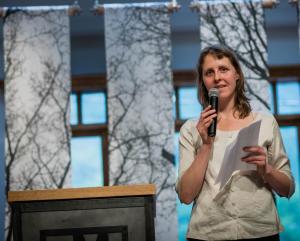 As of this past January, SARAH HOROWITZ has been working as a curatorial assistant at the Picker Art Gallery and Longyear Museum of Anthropology at Colgate University in Hamilton, New York. She is conducting provenance research on objects in the collections and contributing to gallery publications, as well as curating an exhibition featuring the work of contemporary multimedia artist Jaye Rhee, scheduled to open in the fall of 2015.
As of this past January, SARAH HOROWITZ has been working as a curatorial assistant at the Picker Art Gallery and Longyear Museum of Anthropology at Colgate University in Hamilton, New York. She is conducting provenance research on objects in the collections and contributing to gallery publications, as well as curating an exhibition featuring the work of contemporary multimedia artist Jaye Rhee, scheduled to open in the fall of 2015.
’11
SARAH VERBIL graduated from CUNY School of Law in New York City, along with fellow alumnus PATRICK TYRRELL ’08. “Hopefully, by the time of Potash Hill publication, I’ve passed the New York bar and am celebrating by looking for human rights jobs in the NYC area,” writes Sarah.
AMANDA WHITING writes, “I’m the events coordinator at the Brattleboro Museum and Art Center, and after becoming a Get on Board Fellow in Marlboro’s Board Leadership program, I was elected to the board of the Hogback Mountain Conservation Association.”
Recommended Reading, Electric Literature’s emagazine of original fiction, published JOHN THORSON’s short story “All Dogs Go to Heaven with a Vengeance.” “Thorson is a writer who communicates all of this without a moment of explanation— it’s all done through brilliant, transportive writing,” writes the magazine’s editor-in-chief.
’12
“Nothing about the war or the death of friends has ever been easy for me. But I write it all down anyway,” says BRANDON WILLITTS, writing in a Huffington Post blog post last April titled “Why I Write: A Veteran Reflects on Coming Home from War.”
“I understand that the senator had a great time at Marlboro this weekend,” says DREW TANABE, referring to commencement speaker Senator Patrick Leahy. “It is so cool to me that he spoke at commencement.” Drew is a junior staffer for Senator Leahy on agriculture, environment, and energy issues, and is headed to Cambridge University in October for a master’s in environmental policy.
’13
“I’ve been having a phenomenal time creating micro books for around a year now,” says EVAN LORENZEN in an interview on hlntv.com, a CNN network site. The article, titled “These Tiny Books Are a Big Deal,” focuses on Evan’s penchant for creating handmade, illustrated books “smaller than some thumbnails!” such as one called Life’s Lil Pleasures. “I really hope that the book inspires others to investigate the little pleasures in their lives that often go unnoticed or disregarded,” says Evan.
ALEXIA BOGGS is attending law school at the University of Mississippi, in Oxford, Mississippi. “ANNA LUCIA UIHLEIN ’14 and SEAN PYLES visited me this weekend, from New York City and San Francisco, respectively,” she writes. “Coming from the edges of each coast to Mississippi, my former classmates brought with them a special feeling of home away from home. I draw from the lessons I learned at Marlboro on a regular basis. I am focusing on space law—a decision that was first sparked by Eric Toldi ’11 and his Plan on the history of space. In January, I won a negotiation competition and a spot on the University of Mississippi School of Law’s Negotiation Board.” Over the summer, Alexia worked in Washington as a clerk for Senator Patrick Leahy.
’14
MOLLY BOOTH has sold the rights to the young adult novel she wrote on Plan, Saving Hamlet, to Disney-Hyperion Publishing House, in a two-book deal. This past June, she made the move to Portland, Maine, where she lives and fraternizes with other Marlboro alumni. “I write and drink tea all day, and hear my Plan sponsors’ voices in my head constantly,” she says. More to come, but in the mean time learn more in Wicked Local Marblehead.
After serving for several months as the assistant to former president Ellen McCulloch-Lovell, KARA HAMILTON has moved on to the position of admissions counselor for Marlboro College Graduate and Professional Studies. There she is focusing on recruiting candidates for the Master of Arts in Teaching programs.
Graduate and Professional Studies
MAT
LAUREN SUMMA MAT ’02 lives with her husband, Andy, and son, Quen, in Liverpool, Texas. She is currently in her 12th year as music teacher at Melba Passmore Elementary, where she serves as the lead music teacher. “Teaching music to elementary students really is one of the happiest jobs in the world, and I love dancing and singing with happy children all day long,” writes Lauren. She has presented sessions on educational technology in the music classroom at several professional conferences, and is co-director for the Music and Technology Conference of Houston (MATCH), the first-ever music technology conference for elementary music teachers.
DEANNA DONZA MAT ’13, a fourth- and fifth-grade teacher at Monument Elementary in Bennington, Vermont, was honored with a “Bright Spots in Education” certificate from the Bennington chapter of Delta Kappa Gamma Society International. Deanna was chosen both for her work on a Nature’s Classroom trip and for her knowledge of technology gained in the MAT program. Monument Principal Donna Cauley said, “Deanna is known as a mentor to other faculty members in the area of technology.”
Hartford High School teacher MIKE HATHORN MAT ’13 has captured national attention for his statewide program on 3D modeling and local history. “Room 212’s a little bit different than a regular classroom,” he says in a recent video by lynda.com. “I’m trying to make sure the kids at Hartford High School have cutting-edge stuff happening on a regular basis. Every day, the kids come in and they get right to work.”
MBA
“I’m thrilled that I’ll be teaching finance at Bard’s Sustainable MBA program starting next January,” writes KATHY HIPPLE MBA ’13. “Thanks to Marlboro, I had the academic credentials to be considered for the position. During the past few years, I’ve been running a digital marketing firm, Noosphere Marketing, which I founded while at Marlboro. Our firm helps our clients—mostly social enterprises, large financial services, and tech companies—communicate their vision, including their sustainability initiatives.”
Five years after starting the Daughters of Toleza with faculty member Beverly Winterscheid and four other MBA students, DON SIMMS MBA ’11 reports, “Our nonprofit organization supports seven Malawian girls who go to the Bakhita Secondary School, a boarding school located in Balaka, Malawi.” The mission statement of Daughters of Toleza is to “empower one Malawian girl at a time with expanded life choices by supporting her secondary education.”
CleanPowerPerks (CPP), the company started by TESS O’BRIEN MBA ’12, won Green America’s People and Planet Award in March, including a $5,000 prize. “The People and Planet Award will allow us to educate more Americans that clean energy is something anyone can choose and that switching to clean energy through CleanPowerPerks comes with very tangible rewards,” says Tess.
Former faculty and staff No subject is too itchy for retired biology professor BOB ENGEL. He conducted a spring series of lectures at the Osher Lifelong Learning Institute, in Dummerston, Vermont, on the lives of insects.
In July, Wilmington’s Pettee Memorial Library and Bartleby’s Books celebrated the publication of LAURA STEVENSON’s new novel, Liar from Vermont (Brigantine Media, ISBN: 978-1-9384064-2-3). Laura read from her book at Memorial Hall, in downtown Wilmington. Set in the mid-1950s and early 1960s, a time of a rapidly changing landscape in Vermont, the 10 interlocking stories of Liar from Vermont follow a young woman’s quest for belonging.
In 1957, Bruce Cole ’59 and other students attended an astronomy class with physics professor JOHN MACARTHUR at his MacArthur Road farmhouse. Jump ahead 58 years to January 2015, and Bruce was attending a class with the same professor, now 92 years old, in the same farmhouse. This time Bruce and John were joined by Barbara Cole ’59, John’s son Dan, retired ceramics professor Michael Boylen, retired bookstore manager Lucy Gratwick, and a few other old friends, in a lively class titled Energy, Climate Change, and Global Warming. “Such a treat to join in with the old master,” said Barbara, who house-sat in the same old farmhouse in 1957-58 when John and family were in Cambridge while he taught at MIT. “Thanks John for continuing to share your knowledge with your college and community.”
In April, retired anthropology professor CAROL HENDRICKSON gave talks in San Francisco and Portland, Oregon, titled “Crossing Borders: Interdisciplinary Work and Marlboro College Abroad.” The events invited prospective students, alumni, and friends of the college to learn about Carol’s research and Marlboro’s international programs.
“There is really only one circle in the world,” said retired math professor JOE MAZUR, who made a cameo appearance in the spring Penzeys Spices catalog. He was featured in an article about Pi Day (3/14/15, same as the first five digits of pi), in which he discussed the history of applied mathematics, his own fascination with math, and his recipe for “Grandma’s Great-Aunt’s Apple Pie.” Last year Joe published Enlightining Symbols: A Short History of Mathematical Notation and Its Hidden Powers (Princeton University Press, ISBN: 978-0691154633).
In Memoriam

Alan Ternes, former trustee
A resident of Bellows Falls, and a Marlboro Trustee from 1994 to 2004, Alan Ternes died in December 2014 in Denver, Colorado. Born in Detroit, Alan lived for most of his professional life in New York City, moving to Vermont in 1994. He was the editor emeritus of Natural History magazine and former director of the American Museum of Natural History, in New York. He spent his early career as a reporter, then bureau chief, for Stars and Stripes; as a reporter and magazine editor of the Detroit News; and as a city editor at the Times Herald Record in Middletown, New York. He was the editor of the 1975 book Ants, Indians, and Little Dinosaurs, a compilation of articles from Natural History in celebration of the 75th anniversary of the magazine. He travelled widely throughout his life, and in 1998 he sailed his boat “The Nighthawk” solo from Nova Scotia to the Azores—and throughout the Mediterranean over the next 15 years. Alan is survived by his wife, Barbara, and three children.
Milton Randolph, former student
Marlboro’s first African-American student, Milton Randolph, died in June 2015, in Duluth, Georgia. Milton grew up and went to high school in Virginia, and came to Marlboro College in 1951. At Marlboro, Milton gravitated toward music, especially voice. He served on the select board and chaired the Social Committee. According to American studies professor Dick Judd, “Milton has been one of the leaders of the Marlboro College community, and one of the most popular members of the student body.” His Marlboro career was cut short when he was drafted into the army after his junior year, and served with honor as a paratrooper in the 101st Airborne Division. Milton completed his bachelor’s degree in 1962 at Fisk University, in Tennessee. In 2005, Milton was recognized for donating the personal papers of celebrated musician William Levi Dawson, his uncle, to Emory University. He is survived by his wife, Marian, and daughter Jennifer.
Richard Coutant ’69 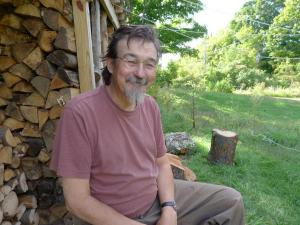 Longtime Guilford neighbor Richard Henry Coutant III died at home in June, six weeks after being diagnosed with pancreatic cancer. Richard was 67. He was born in New Jersey, and his family moved to East Bethel, Vermont, in 1953. He graduated from Montpelier High School, and at Marlboro he studied history and did a Plan of Concentration on the development of social institutions in early England. For many years he ran the CETA (Comprehensive Employment and Training Act) office in Brattleboro and became well known for his compassion and creativity. After a brief first marriage, he met and wed local poet and teacher Verandah Porche in 1979. With that union, he became the proud father of Oona Adams FS94 and then Emily Julia Coutant, born in 1981. In 1986 he received a law degree from Vermont Law School, where he graduated magna cum laude, and began work in Bellows Falls for the law firm of Salmon and Nostrand, where he remained until his death. He leaves his wife, daughters, son-in-law, granddaughter, and sister, Christopher Coutant ’71 of Brattleboro.
Longtime Guilford neighbor Richard Henry Coutant III died at home in June, six weeks after being diagnosed with pancreatic cancer. Richard was 67. He was born in New Jersey, and his family moved to East Bethel, Vermont, in 1953. He graduated from Montpelier High School, and at Marlboro he studied history and did a Plan of Concentration on the development of social institutions in early England. For many years he ran the CETA (Comprehensive Employment and Training Act) office in Brattleboro and became well known for his compassion and creativity. After a brief first marriage, he met and wed local poet and teacher Verandah Porche in 1979. With that union, he became the proud father of Oona Adams FS94 and then Emily Julia Coutant, born in 1981. In 1986 he received a law degree from Vermont Law School, where he graduated magna cum laude, and began work in Bellows Falls for the law firm of Salmon and Nostrand, where he remained until his death. He leaves his wife, daughters, son-in-law, granddaughter, and sister, Christopher Coutant ’71 of Brattleboro.
Melissa Ann Spore ’71
For many years a self-employed instructional designer, Melissa Spore died in May in Saskatoon, Saskatchewan. Melissa grew up in Virginia before coming to Marlboro College, where she did a Plan of Concentration on Victorian literature, specifically the poetry of Tennyson. She went on to attend Columbia University before moving to Canada in 1974. She moved to Saskatoon in 1996 to take up a post with the University of Saskatchewan, where she was involved for many years in distance education. “She was passionate about both the benefits of sound, democratic education and the perils of bad education,” said her brother, Stuart Spore ’69. “Her thinking was very much informed by her time at Marlboro.” Melissa was the co-author (with her sister Sally Bigwood) of The Designer’s Guide to Presenting Numbers, Figures, and Charts. She is survived by her brother, sister, brother-in-law, and niece.
Anne Granwell, former student
A resident of Troy, New York, Anne Granwell died in February 2015 at Evergreen Commons Nursing Home in East Greenbush. Born in Manhattan, she graduated from the Charles E. Ellis School for Fatherless Girls in Newtown Square, Pennsylvania, before coming to Marlboro in 1967. Anne focused on English, and after leaving Marlboro was an aspiring writer and the author of a local newspaper column called “The Country Mouse.” Anne’s marriage to Marlboro alumnus Bennett Blackburn ’70 ended in divorce, and she later married John Meringolo. She was the mother of three sons. She once wrote, “Have enjoyed Potash Hill very much all these years…. You’ll always be that special school for me.” While living in Troy, Anne was a volunteer at the senior center there, and in her spare time she was an avid reader and an enthusiastic promoter of Marlboro College on social media.
Susan Keese, former staff member
Editor of Potash Hill in the late 1980s and early ’90s and longtime public relations director for Marlboro College, Susan Keese died in March 2015 at the age of 67. Susan started her Vermont news career with the Rutland Herald in 1982, and went on to become an award-winning correspondent for Vermont Public Radio and producer of the station’s Vermont Edition show. She developed a following across the state with her distinctive voice, empathetic style, and cadenced delivery. “Susan was not only a great reporter, she also was a huge friend to Vermont,” said Governor Peter Shumlin. He praised her for “reporting accurately and with extra care” about sensitive issues, such as the Vermont Yankee nuclear power plant and the closing of the Austine School for the Deaf. Susan leaves her husband, John “Bud” Pyatak, a retired South Newfane lawyer, as well as two children and three grandchildren.
Mary Karis, staff member 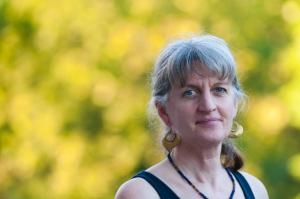 The program coordinator for the MBA in Managing for Sustainability and MSM in Mission-Driven Organizations programs for several years, Mary Karis died in June after a struggle with cancer. She was surrounded by a circle of friends and family throughout this experience as, in her own words, she “met and worked with” the illness that had come into her life . She had a deep connection to nature and drew strength and learning from it to her last days. “Mary shared deeply of herself in her service not just to the MBA and MDO programs but to each individual associated with them,” said Sean Conley, associate dean for graduate and professional studies. “She was an important and connecting presence, alert to the needs of others and quick to give help or comfort.”
The program coordinator for the MBA in Managing for Sustainability and MSM in Mission-Driven Organizations programs for several years, Mary Karis died in June after a struggle with cancer. She was surrounded by a circle of friends and family throughout this experience as, in her own words, she “met and worked with” the illness that had come into her life . She had a deep connection to nature and drew strength and learning from it to her last days. “Mary shared deeply of herself in her service not just to the MBA and MDO programs but to each individual associated with them,” said Sean Conley, associate dean for graduate and professional studies. “She was an important and connecting presence, alert to the needs of others and quick to give help or comfort.”
Magnanimity Cum Laude
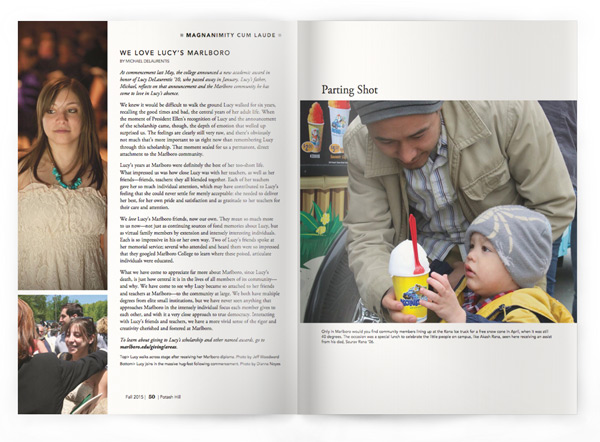
We Love Lucy’s Marlboro
By Michael DeLaurentis
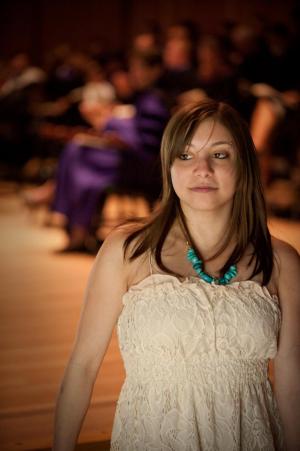 At commencement last May, the college announced a new academic award in honor of Lucy DeLaurentis ’10, who passed away in January. Lucy’s father, Michael, reflects on that announcement and the Marlboro community he has come to love in Lucy’s absence.
At commencement last May, the college announced a new academic award in honor of Lucy DeLaurentis ’10, who passed away in January. Lucy’s father, Michael, reflects on that announcement and the Marlboro community he has come to love in Lucy’s absence.
We knew it would be difficult to walk the ground Lucy walked for six years, recalling the good times and bad, the central years of her adult life. When the moment of President Ellen’s recognition of Lucy and the announcement of the scholarship came, though, the depth of emotion that welled up surprised us. The feelings are clearly still very raw, and there’s obviously not much that’s more important to us right now than remembering Lucy through this scholarship. That moment sealed for us a permanent, direct attachment to the Marlboro community.
Lucy’s years at Marlboro were definitely the best of her too-short life. What impressed us was how close Lucy was with her teachers, as well as her friends—friends, teachers: they all blended together. Each of her teachers gave her so much individual attention, which may have contributed to Lucy’s feeling that she could never settle for merely acceptable: she needed to deliver her best, for her own pride and satisfaction and as gratitude to her teachers for their care and attention.
We love Lucy’s Marlboro friends, now our own. They mean so much more to us now—not just as continuing sources of fond memories about Lucy, but as virtual family members by extension and intensely interesting individuals. Each is so impressive in his or her own way. Two of Lucy’s friends spoke at her memorial service; several who attended and heard them were so impressed that they googled Marlboro College to learn where these poised, articulate individuals were educated.
What we have come to appreciate far more about Marlboro, since Lucy’s death, is just how central it is in the lives of all members of its community— and why. We have come to see why Lucy became so attached to her friends and teachers at Marlboro—to the community at large. We both have multiple degrees from elite small institutions, but we have never seen anything that approaches Marlboro in the intensely individual focus each member gives to each other, and with it a very close approach to true democracy. Interacting with Lucy’s friends and teachers, we have a more vivid sense of the rigor and creativity cherished and fostered at Marlboro.
Learn about giving to Lucy’s scholarship and other named awards.
Parting Shot
Only at Marlboro would you find community members lining up at the Kona Ice truck for a free snow cone in April, when it was still 40 degrees. The occasion was a special lunch to celebrate the little people on campus, like Akash Rana, seen here receiving an assist from his dad, Saurav Rana ’06.
Special Web Features
Waiting Space: Story by Phoebe Lumley '15
Dad and I had driven for five hours, and we’d barely done more than smile at my aunt and kissed Grandmother’s hollow cheek when a doctor appeared in the door of her hospital room to herd us back out. My aunt put aside her knitting and led the way down the hall, hands stuffed in the pockets of her black down vest.
“It’ll be about ten minutes,” she said over her shoulder, not slowing for us to catch up. Dad moved stiffly after her, trying to stretch his back while he walked. I glanced back at the closed door of Grandmother’s room, down the now-empty hallway, and slipped my feet out of my winter boots. I stuffed the socks Mom knit me in the mouths of my boots, leaving them neatly lined up next to the door, then set off after my relatives, walking slowly so no one would notice my bare feet.
I paused at the bank of elevators, then followed my father’s laugh down one of the two halls that stretched identically away from me. At the end was a kind of waiting room, an abrupt end to the hallway with a couple chairs and a little table next to a huge window. The hallway, carpet, and chair upholstery were all different shades of beige. I joined my aunt and Dad at the end of the hall, but stayed standing, kneading my bare feet against the nubby carpet like a cat, trying to shift my weight without moving my toes outside of the little ecru squares. The fluorescent lights turned my skin a sickly shade of greenish-pale, like linoleum in a diner bathroom.
“Shouldn’t you have shoes on?” said Dad, in one of the oatmeal-and-biscuitchecker- boarded chairs. The corner felt close, too warm, the three of us taking up all the breathable air.
I shrugged. No nurses were in sight, and the carpet gave under my feet like moss. I felt I’d been wearing my boots for the past four months straight. Recordsetting snowfalls called for wool socks twenty-four hours a day and boots wherever I went, but the weight of them dragged on my feet. The inside of the hospital was seasonless—clean and quiet, the decor unobtrusive, the lighting removing any sense of time. The induced peace and serenity made me want to scream.
My aunt gazed out the window at the flat grey sky, almost a match for the concrete roof that stretched between our window and the next section of the building, a slim railing running along the edge, ending at a door. Her shoulders squared deliberately, stiff even in this moment of rest. Her whole body carried the same waiting look that Grandmother had in her eyes, except that my aunt was braced for impact, braced to survive. Grandmother was waiting for the blow she couldn’t duck—a flash of fear had lit up behind her glasses when the doctor entered her room.
Waiting in silence felt wrong, but so did talking about what we were waiting for. My aunt was a dedicated cook, and I thought about mentioning the biscotti I had recently made from scratch, but Mom and I had eaten them all—I hadn’t brought Dad any. I wracked my mind for a topic of conversation that didn’t have anything to do with illness, my life with Mom, Dad’s horrible financial situation, or politics, and came up blank. These were exceptional circumstances, but every visit with my aunt felt like an essay question on a test I hadn’t studied for.
Dad leafed though a nondenominational book of prayer someone had left on the miniature coffee table, looking up at the paintings to mutter, “Whoever decorated this place had no imagination.” His red suspenders, green plaid shirt, and paint-spattered jeans seemed unnaturally bright in the sea of beige.
My aunt glanced at her watch, the streaks of grey in her hair mirroring the lines on her face. “We can head back now.” She turned on her heel, tucked her hands into the pockets of her puffy vest like a hawk folding its wings, and headed down the hall, her feet landing firmly on the carpet again and again, a dependable heartbeat. Dad tossed the book back on the coffee table, heaved himself to his feet, and set off after her, favoring his bad hip.
I kneaded the carpet once more, enjoying the moment with no one near me, then started as a figure appeared outside the window and across the roof. A guy wearing scrubs, but just a few years older than me, propped open his door to the roof with one of his shoes. He leaned on the railing, bare foot resting on the other shoe, and lit a cigarette. Glancing up, he noticed me and quirked an eyebrow.
Tentatively, I lifted a hand. He raised his empty hand slowly in response. I could feel his eyes on me all the way down the silent hallway.
•
Slipping unnoticed into Grandmother’s room, I took a seat by the far wall, jammed between the tiny closet and the machine that told us her heart rate. I settled my computer on my lap. The oxygen tank on the other side of the bed wheezed as Grandmother’s chest rose and fell, her breathing separated from the sound. Occasionally, Grandmother took a tiny sip of water through a straw, then coughed as if she had an ocean swirling through her lungs, drowning her even as she sat propped up against a mountain of pillows.
I stared at the screen of my computer. In his essay “Circles,” Emerson shows that we are all connected, that every seemingly separate part of the world is really intertwined, and therefore we exist in a state of cohesion…
Oh, shut up, Emerson.
My aunt’s knitting needles clicked away on a hideous hat for her future daughter-in-law. “She’s fine, her family is just very different from ours. Catholic. They’re not Republican, but they’re definitely conservative.”
“I don’t like that she was in a sorority,” said Grandmother, turning her large head on her tiny neck like a baby bird waiting for food to be dropped in its mouth. “And she said that she only joined so she could attend parties and have alcohol. As though that made it better.”
Grandmother’s hands were twitching on the blanket, empty without her cigarette. She hadn’t had one in nearly 48 hours. The hospital didn’t allow smoking, and anyway, she was on oxygen. My aunt had stayed at the hospital every night since Grandmother checked in, monitored all of Grandmother’s medication, and dealt with all the doctors. Under normal circumstances, neither of them would ever have said these things. Not about the sweet, kind basketball player my tough-as-nails cousin was head-over-heels in love with, was going to marry and raise adorable blonde children with. The woman my aunt and Grandmother welcomed with open arms at the last family event. They wouldn’t really talk about her with that edge in their voices, their words as swift and pointed as my aunt’s needles.
Or maybe I hadn’t been listening, before. I glanced down at my hands on the keyboard, the little gold signet ring on my pinky, the initial of my first name pierced by the larger letter of my family.
“What are you working on, sweetheart?” Dad glanced up from his crossword.
“A response to an Emerson essay.”
“Ah, Emerson.” Grandmother smiled. “Are you enjoying his work?” I hesitated.
“It’s—very interesting.”
“I remember reading Emerson,” said Dad, putting down his crossword and twirling the pencil between his fingers like a baton. “Or maybe Thoreau? Do you remember the teacher I had my first year of high school, who gave me all that reading that it took me two semesters to slog through?”
Grandmother furrowed what was left of her eyebrows. “When we lived in Pennsylvania?”
“The house on Williams Street,” said my aunt, not looking up from her knitting.
“Ah,” said Grandmother, nodding. “Yes. The year your sister decided to stop being vegan because she didn’t like the synthetic paintbrush bristles.”
“Dad never stopped giving her a hard time for that.” My aunt raised her eyes from her knitting to grin at Grandmother, the corners of her mouth tightening as she took in the knobby hands shaking on the covers, each time as alarming as the first.
Grandmother laughed, the rest of her body shaking nearly as much as her hands. “No, he never would let her forget it.”
“Have you talked to her today?” asked my dad, raising his eyebrows at my aunt.
“Well,” said my aunt, diving back into her knitting as she began to recount the anxieties of their artistic sister.
I tried to tune out and focus on Emerson. We had had nearly the same conversation when we arrived. Circles, circles, circles…
•
When the essay had finally emerged, I stood up, left my computer on my chair, and retreated into the beige hallway. Padding through the puddles of florescent light, I glanced at my reflection in the dark windows, the outline of my face soft, my body insubstantial. I took a few random turns, moving into what felt like the depths of the hospital. Quiet carpet, soft coughs from the wheels of trolleys and wheelchairs driving along in hallways just out of sight, murmurs at the nurses’ station, no one looking up from their charts and computer screens to notice my bare feet. Following a little corridor with tiles instead of carpet, I came to a door ajar, propped open with a shoe and letting in a stream of air that didn’t smell like disinfectant. Nudging it further open, I stepped over the shoe and onto the concrete roof.
“Careful.” A hand holding a cigarette reached past me to catch the door before it closed, and the nurse stepped into my view, leaning down to replace his shoe in the crack of the door. “Don’t want to get locked out.”
He leaned against the railing, gazing out over the hospital’s half-full parking lot to the highway beyond, and I moved over to stand next to him. Close up, he looked a little older than I had first guessed, but not much—still under thirty. A tattoo peeked out from under the sleeve of his teal scrubs, text that slid around his arm. I tilted my head, trying to read it.
“Visiting?” he asked, blowing out a thin stream of smoke.
I looked quickly away from his arm, but he didn’t seem to have noticed me staring. “Yeah.” There were deep shadows under his eyes and along his jaw. “Long shift?”
“This is hour twenty-nine. One more, and I can go home.” He glanced down. “Aren’t your feet cold?”
I followed his gaze to my bare feet with their chipped red toenail polish. His feet were just inches away, one shoe off and one shoe on, like the nursery rhyme. “Aren’t yours?”
He grinned. “Just the one.”
I smiled, leaning against the railing next to him, the sun already set somewhere behind the clouds. Visiting hours would end soon, and Dad and I would go to Grandmother’s empty house, still thick with the scent of cigarette smoke. Dad would sleep in his parents’ bedroom, which Grandmother hadn’t slept in since Grampa died, preferring her padded chair in the kitchen. My aunt would sleep in the chair next to Grandmother’s hospital bed, and would wake up stiff and sore, Grandmother’s shaky hand clasped in hers.
The nurse stretched his arm along the scuffed expanse of railing between us, offering me his half-smoked cigarette. I had never smoked in my life, but I took it between my fingers, cradling it as Grandmother always did, Grandmother who couldn’t swallow now, who choked on a single drop of water. The filter was soft and wet, still warm from his mouth. I inhaled and held the strange warmth in my lungs. When I passed the cigarette back to him, our fingers met—smoke rose from between my lips and faded into the grey sky, covered rim to rim with clouds that, before the night was through, would release a fresh blanket of snow and cover the rough edges of the world in purest white.
Not looking at everything the same way: An interview with John Willis
Photography professor John Willis was visited by junior Shannon Haaland to talk about how he first came to Marlboro, advice he gives photography students, and how new students help keep his own vision fresh.
Shannon Haaland: So when exactly did you start working here?
John Willis: I taught one class here as a barter situation in 1980. I had just gotten my undergraduate degree, moved to the area, and was looking for things to do. I met some people who were Marlboro students, who said there was a darkroom in the science building here. There was an enlarger and no one knew how to use it, and they had nobody to teach photography. And I thought, “well that sounds interesting,” and I came up and I offered to teach a class. The dean said there was no money for it—students weren’t allowed to do Plans in photography at the time.
SH: Really?
JW: Yeah, but I took one or two classes in exchange for teaching a class as an evening elective. I had six students who worked really hard, and I taught here for one semester on the barter system, then ten years later, after receiving my MFA, I found out about a job here and came back. I was part-time for seven years—back then all of the art faculty were part-time, except for the painting teacher. Then there was a foundation grant that made it so all the visual arts faculty could be full time.
SH: Did you want to go into teaching?
JW: I didn’t go to school thinking I would be a teacher. Well, I thought I might teach little children, but I was more thinking about childhood education and child psychology. In graduate school I ended up going for photography. I worked in the field for five years after my undergraduate work, and then someone convinced me I could go to grad school and have a “sabbatical” from the working world. I went just to be around other people doing photography as documentary and art, and to have the opportunity to work on my own stuff, and I really loved it. The thing was, in graduate school you can get assistantships, where you get paid part of your tuition in exchange for working, and one of my assistantships was teaching. And I loved it, and just sort of got hooked.
SH: Do you have advice for students who are going into photography?
JW: That’s a hard one, I think because the world is changing so much. There are definitely jobs out there, but when I was in school there were a lot of students, probably still are, who went to school thinking they could become famous artists and make money off their artwork. And some people can, but it is incredibly competitive. If people are doing photography or other forms of art because they are interested in the medium, and passionate about it, and want to have it in their life, I think there are plenty of ways to be a working professional in the art world, whether that’s doing photography or working in galleries or other possibilities. There are a lot of opportunities, but they may not necessarily involve selling your personal, creative work.
SH: Okay.
JW: It’s definitely worth putting art and creativity into your life, if that is what you are inspired by. There are so many ways to have that contribute to making a living and, beyond that, contribute to having a really interesting and fulfilling life. I know people who are really active photographers and artists of all different kinds who don’t make their living through sales of their artwork. Maybe their living is some really different kind of job, and yet art is one of their favorite things that they have in their life. They have a whole community of artists that they share their work with, help each other, inspire each other, exhibit each other’s work.
SH: What if someone wants to get a job with their artwork?
JW: I’d say this to a student in probably any field: in addition to studying the field and getting a degree in the field, it’s really important to do anything and everything you can to build your resume and your credibility and experience in that field. Right now there are so many people getting degrees in any field, so that when a job opens up there are hundreds of applicants, and resumes are being sent in on the internet so they don’t get to meet you as a person, necessarily. You need to figure on the majority of those people probably have bachelors degrees in that field, so what are you going to do to set yourself apart from them?
SH: Like what?
JW: A big aspect is things that you have done alongside of your classes. I don’t mean to belittle the classes, because I think college is really important. Studying your field is really important in getting a foundation, but as far as getting a job and standing out in the crowd, you need more experience through internships, volunteer work, student employment, summer work, winter work—any opportunity you can to get lines on a resume, you know, that show experience. Not just for the sake of having a line on a resume, but for the sake of having that experience.
SH: What about having art shows?
JW: People who want to collect work and buy work, they’re not just looking at images they like. There is not a standard set of what a good image is, and what it’s not. So when somebody sees something they like, and has the money to buy it, they are much more likely to buy it if other people like it and have bought it too. So it helps to just have more shows to really get the work out there.
SH: What do you like most about working with Marlboro students?
JW: It’s probably the same story you’d hear from anybody, that Marlboro students designing their own Plans of Concentration bring their interests to the table. I think like 85 percent of them—I’m taking a wild guess there—have interdisciplinary Plans, so I am always learning about different relationships and different topics and different contemporary issues. It keeps it really exciting. I’m learning things all the time from students. When I started working at Marlboro that wasn’t something you would hear about happening at many other schools. It’s not as unique as it used to be, but I still think it feels unique by the way the students are and the size of the school, the location of the school. Marlboro students who tend to work really hard, and do some pretty amazing work, and it’s very motivating. I love the time of year I get so busy I don’t sleep regular nights, like Plan students.
SH: So students still surprise you with their work?
JW: Honestly, even intro class students surprise me with their work, and intro is where you are trying to teach promising new students the same fundamental subject matter, every semester. Almost every semester I have taught intro and there are certain mechanical things, logistical things, ways to use the camera, I have to teach in every one of those classes. It seems like it would be incredibly repetitive, but what always makes it surprising is that every student comes to it from a different mind and different abilities, and creates different images. Even at an intro level I think it’s really exciting, but at a Plan level, it just magnifies and becomes really, really interesting.
SH: What are your own current photographic interests?
JW: Well I’m doing a few different projects. It’s always hard to photograph, edit photographs, and print photographs during the school year, but I’m usually doing some aspect of that. I just had a show at Greenfield Community College that was all about issues around housing on Native American reservations, particularly the Pine Ridge Reservation in South Dakota and the Navajo. I’ve spent a lot of time on the reservation, and it’s a response to the community there. There are so many people who live in trailer houses—nothing against trailers, or people who live in trailers I should say—but they are not well made, they are not appropriate houses for living in the open plains where it gets freezing cold. The insulation is really bad and they just fall apart in storms.
SH: Yikes.
JW: I learned that when the Katrina houses were taken back, because they were deemed by the government to be too poisonous, they started giving them to reservations. To me this was yet another example of how this government really takes advantage of marginalized, disadvantaged people, in this case First Nation people who were there before the dominate culture. I made pictures on the housing and an architectural student from Yale was doing his thesis on the same issue and he wrote sort of a Trail of Tears text to go with it about the history.
SH: Sounds amazing. Anything else you are working on?
JW: I’m doing a project for the Vermont Land Trust where I’m doing work on a farm that they own, the Bunker Farm. I intend on mixing those images with pictures I’m making of a metal scrap yard illustrating excess consumption, just thinking about how we deal with land, land use, goals for the land, and things like that. I’m going to collaborate with Matan Rubenstein—he’s been coming along sometimes and making audio recordings of ambient sounds while I’m photographing the sites. Our intentions are to put pictures together from the sites and he’s going to compose a musical score from the found pieces. So I’m excited about that.
SH: Have students helped you in your own work process?
JW: Well I get a lot out of working with students—the whole thing of not looking at everything the same way, and trying to experience the world differently. I learn as much about keeping an open mind, and being active, from seeing how students approach things as from anywhere else.
SH: How have Marlboro students helped out with your work at Pine Ridge?
JW: Exposures, the cross-cultural youth summer program based in Brattleboro, part of the In-Sight Photography Project, was created with five Plan students. I don’t think it would have ever happened, if it wasn’t for this group of students that decided they were going to do this together without pay or credits. We met once a week for a semester and just talked about creating a program at Pine Ridge and taking students from the In-Sight Photography Project, in Brattleboro. It never would have grown like it did without students. You know, the only reason there is a photography program is because of students. The only reason why there is a film program is because of students. Whenever there is a student interest strong enough it just sort of bubbles up. When students have interests, and the interests keep growing, the faculty and administration can’t deny it and then it grows.
SH: Can you think of a time where being a photographer let you see more into a world than you normally would?
JW: We took students to China for three weeks and we were in Turpan, over on the western side near the Gobi Desert, where there was a Muslim separatist area. I was walking around alone with a camera over my shoulder and there was a father with two kids playing in some water and they were just having a great time. I couldn’t speak their language—I couldn’t speak Arabic; I couldn’t speak Mandarin—and they couldn’t speak English, but they were able to make it known, through a kind of charades, that they were playing. They could tell I was a photographer, and they didn’t care if I took their pictures. So, I stood there taking pictures in the road, just doing some landscape stuff in this rural small community. It turned out they were on there way to a wedding, a double wedding, and they dragged along and had me photographing this Uyghur wedding. There is a double wedding portrait up in Mather that comes from that time.
SH: I need to look for that.
JW: It was an amazing afternoon. We could not communicate, and then at the end I wanted to get an address so I could mail them the prints, because they were so generous. It took a while to find someone who understood enough English that they could translate, and I found a Chinese man who could understand just enough to get that I was trying to get an address, and then he had to find someone to translate to them so it took three people to find a way to get an address. They didn’t even have a mailing address, because it was such a rural place, so we had to figure out how somebody knew somebody who had an address who I could send prints to. It was cool. I mailed those prints; I have no idea if they ever got them. I mailed them a pile of wedding portraits that included some that we 20 by 24 inches, it was so much fun meeting them.